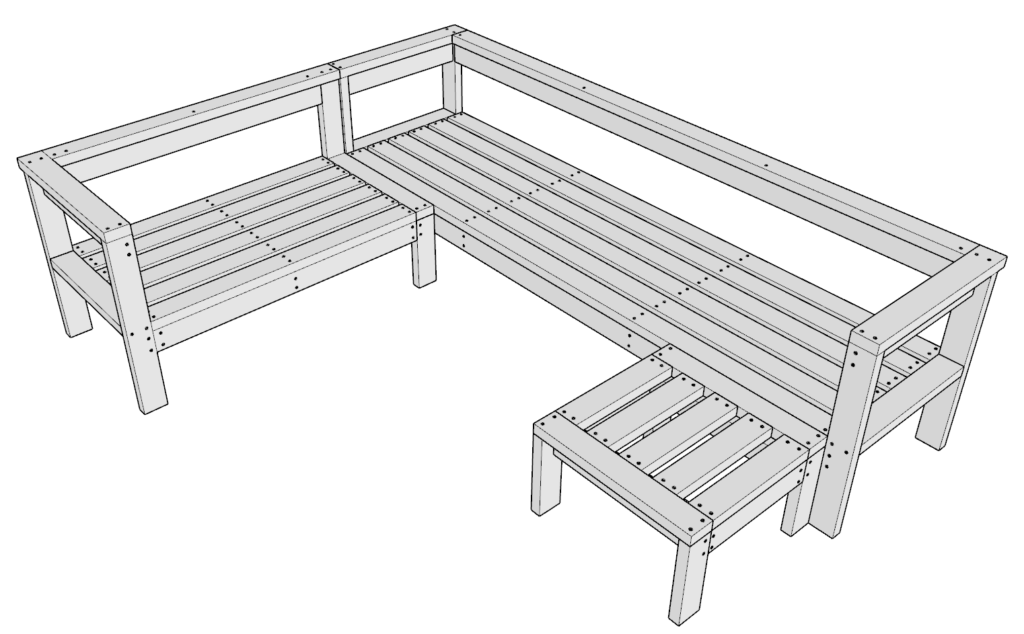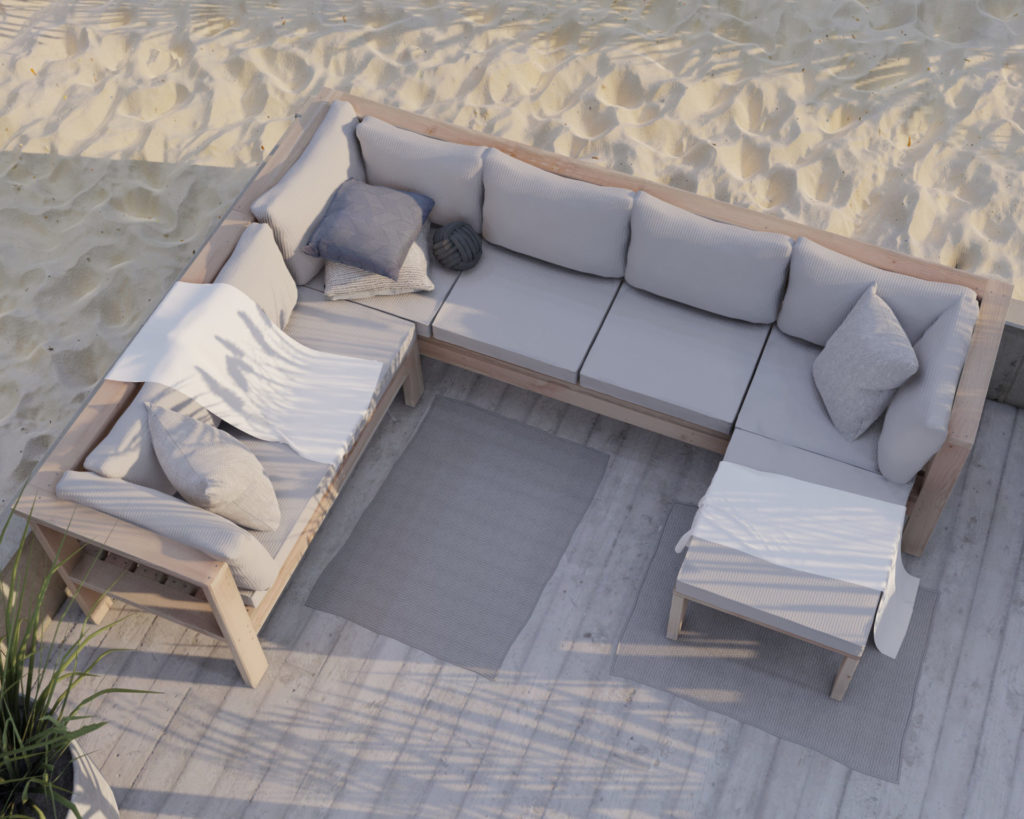Why build a DIY outdoor sectional?
The DIY outdoor sectional is simple, inviting, and is perfect for enjoying the outdoors, the fresh breeze, the garden, and greenery. You can better enjoy your backyard space all year round and be inspired by the changes of the seasons.
The minimalistic and simple wood bench design is built from inexpensive 2×4’s but looks like a million bucks! The DIY patio bench is great for creating a space for entertaining. You can create a more perfect space that offers comfortable seating for parties, barbecues, and get togethers at home.
This DIY outdoor sectional bench is inexpensive to make and is an ideal project for those who don’t have a lot of tools or experience with woodworking. The step-by-step instructions offered in this post will ensure that you get the result you want without making mistakes or wasting material. This entire build is from 2×4’s lumber that can be purchased from most hardware stores.
Why build using our DIY outdoor sectional plans?
We don’t just have one-off pieces available for our customers, we design entire sets.
Every home is different, and the versatility of building using our outdoor furniture plans allows for you to configure the outdoor living space in a manner that suit your needs.
Check out the “outdoor” section of the site for additional plans that fit this set.
Specifics of the DIY outdoor sectional.
These DIY outdoor sectional sofa plans not only features the beauty of natural wood, but are also extremely resilient and requires minimal maintenance. Using sold 2×4 lumber pieces ensures a long lasting and quality piece of furniture that will last through years of use, abuse, wear, and tear. Wood furniture can often last for generations.
I got the inspiration for this build from Ana White a few years ago and decided to modify and improve on it. I have been building this modified version for customers for years now with great success. This Ana White inspired DIY outdoor sectional is a great option for anyone thinking about building custom seating.
The arm rests of the DIY patio bench are reinforced by additional 2×4 lumber pieces to prevent pillows and cushions from falling through.
The sturdy frame is jointed with simple screws and reinforced with glue. This not only makes the build easy and beginner friendly, but it also makes the bench able to support multiple people sitting on it at one time.
Once the outdoor sofa is done, you can make it comfy and cozy by adding cushions, pillows, and blankets. Cushions can be purchased at stores like Home Depot, Lowes, Ikea, Target, etc. You can also have cushions custom made for the DIY patio bench. The seating platform of the bench is made to accommodate 24 in x 24 in base cushions and variable height (minimal 12 inches tall) back rest cushions. Cushions that are a little different then 24 in x 24 in typically work just fine.
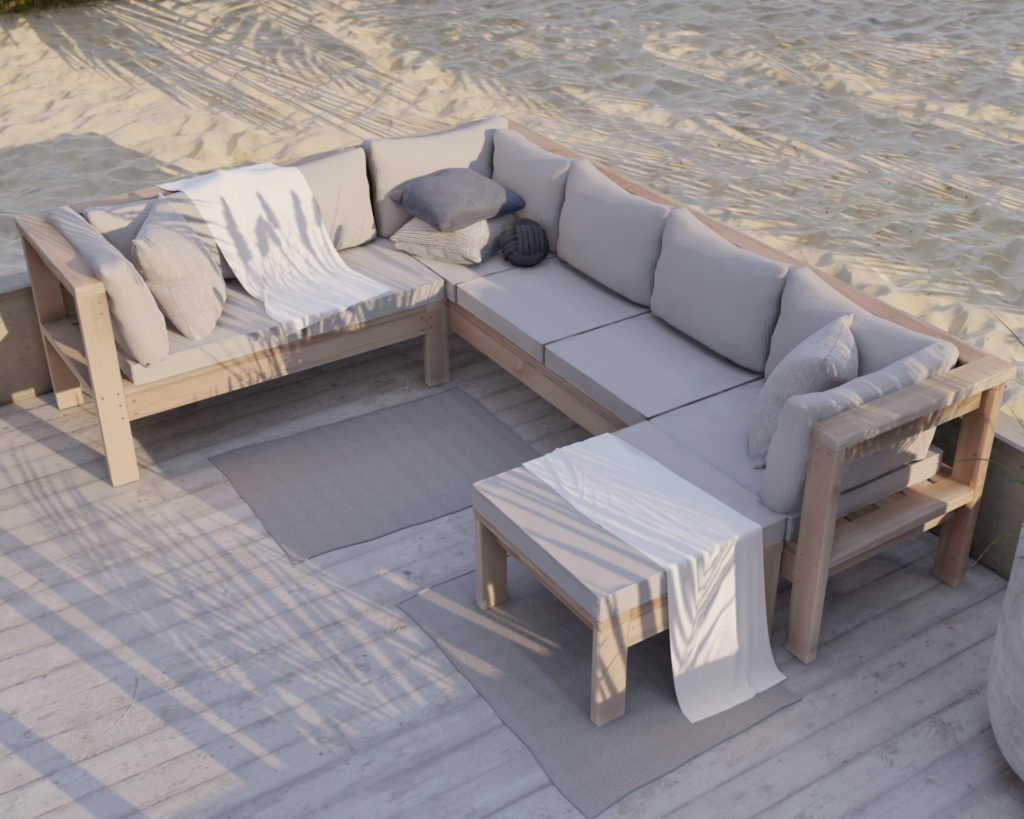
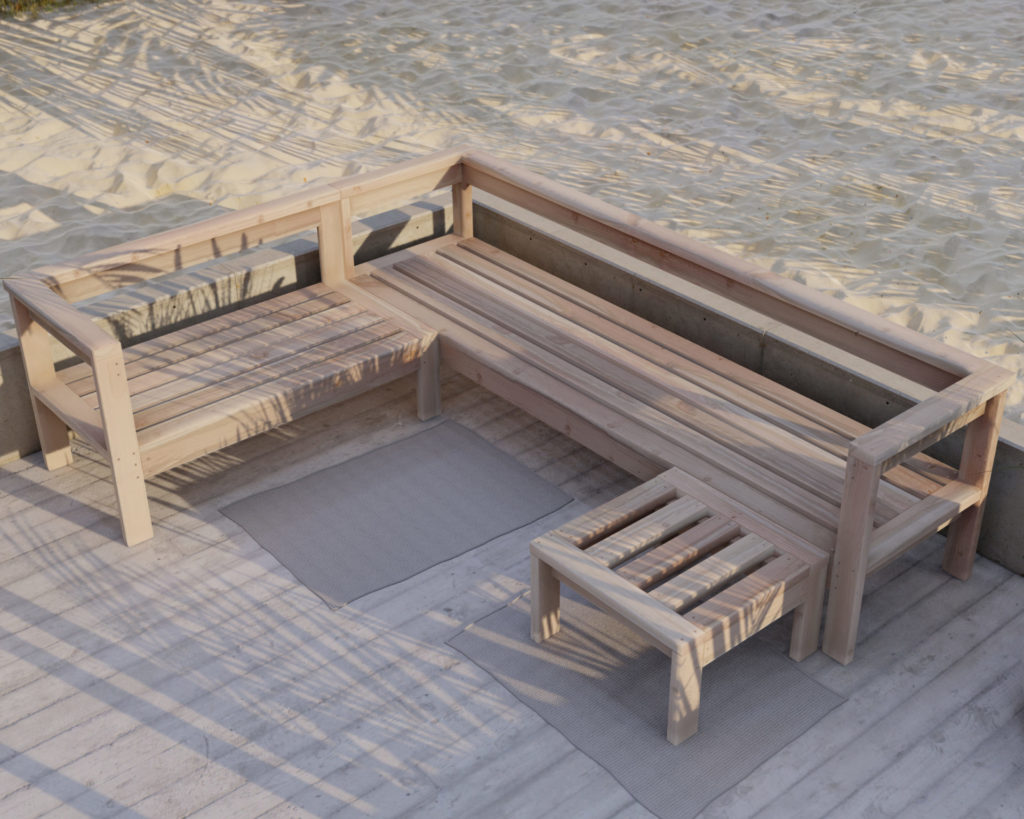
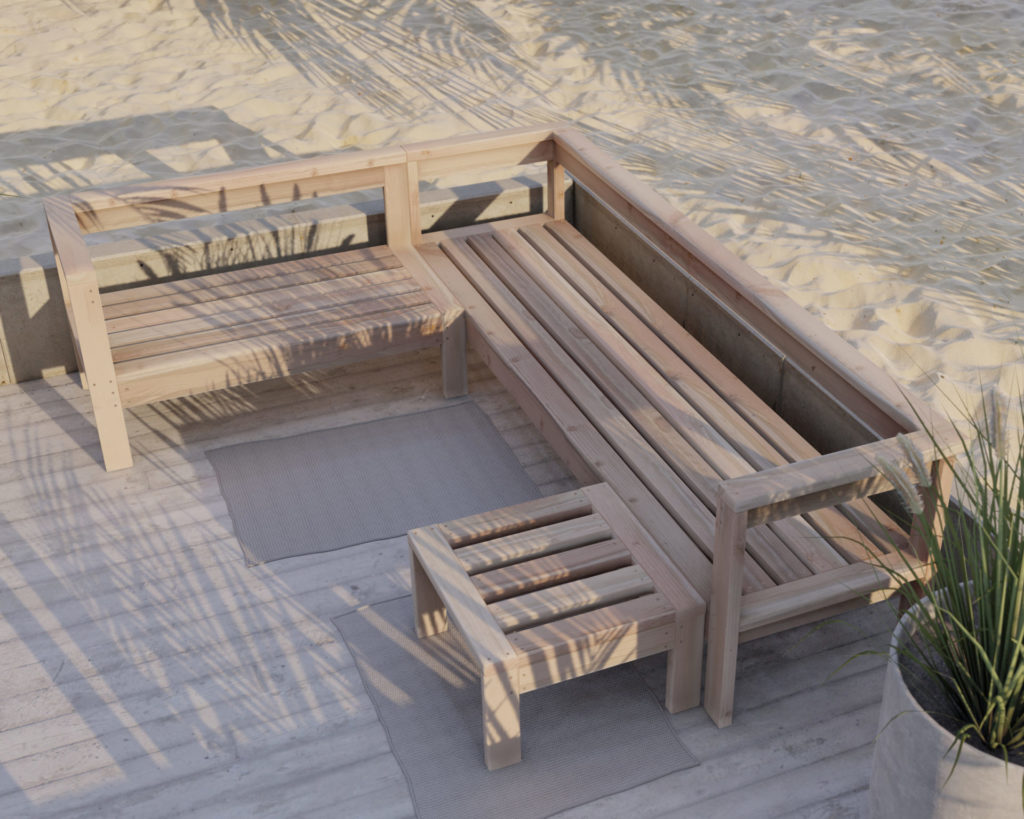

Time to build
About 6 hours
Total cost of build
About $275 (cushions and pillows not included in cost estimate).
Skill level required
Beginner-Intermediate
Download the PDF plans
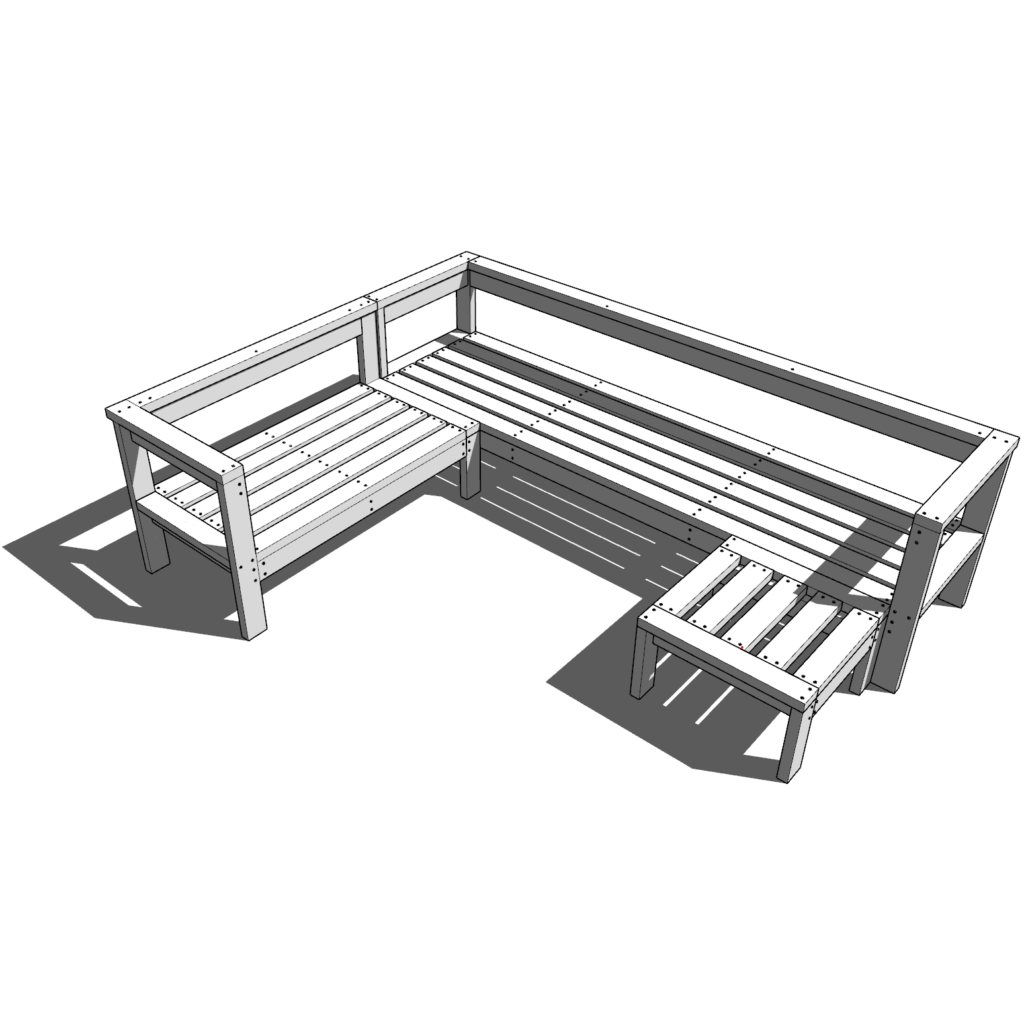
Outdoor wood chaise sectional patio bench PDF
What is included in the PDF download?
- Easy to read step by step instructions
- Material list
- Cut list
- Tools needed
Step-by-step instruction on building the 103 inch 4-seater bench
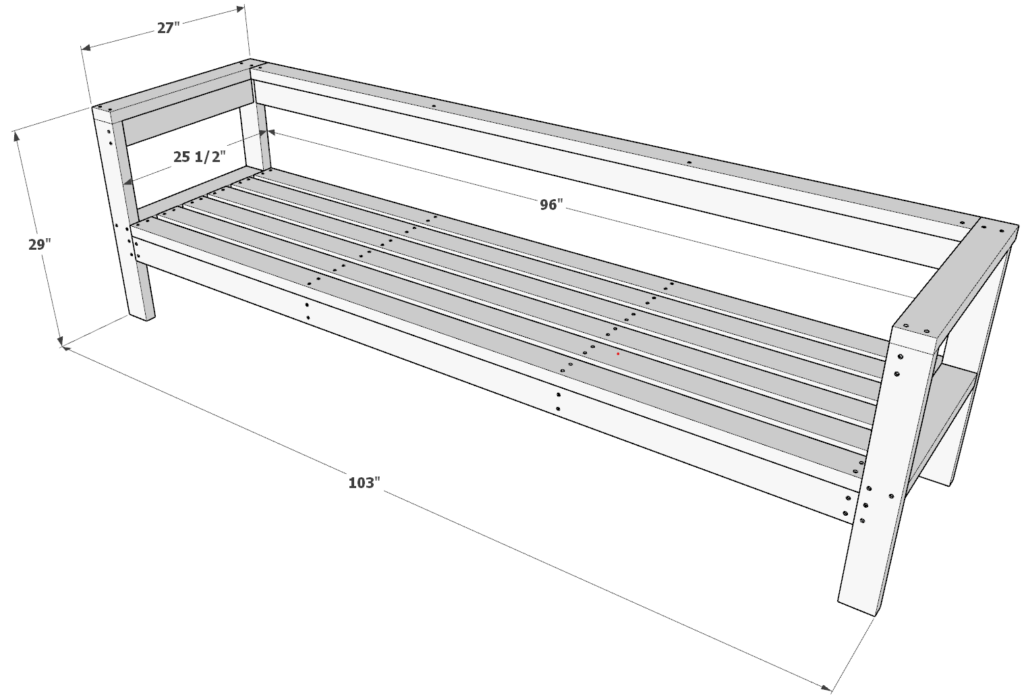
Recommend tools for this project
- Saw (miter saw recommended for precision cuts)
- Drill
- Impact driver with bit for screws
- GRIP Clamps
- Sander
- wood countersink drill bit
- Pipe clamp grip, tie downs, or straps.
Cut list and material list
Available with purchase of PDF plans.

Step 1 (DIY patio bench frame assembly)
Take two 96 inch 2×4 lumber pieces and four 22.5 inch 2×4 lumber pieces and arrange them as shown bellow.
Join the pieces by predrilling holes, add glue, and add 2.5 inch long screws.
It is recommended to predrill the wood prior to putting in a screw to prevent the wood from splitting. What works for me is to us a wood countersink drill bit.
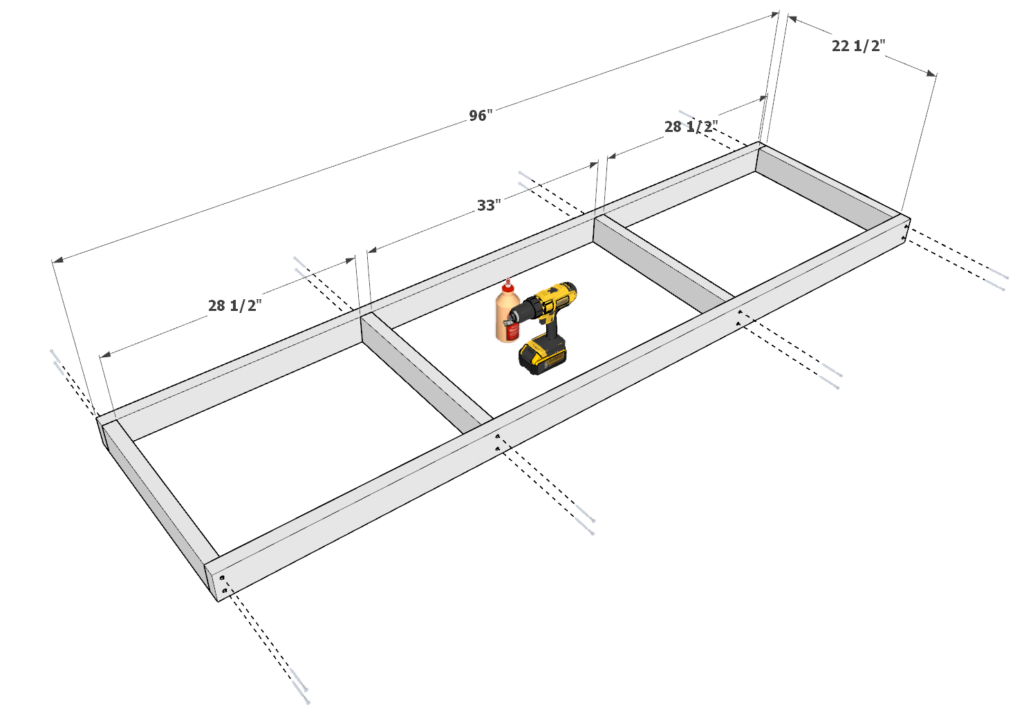
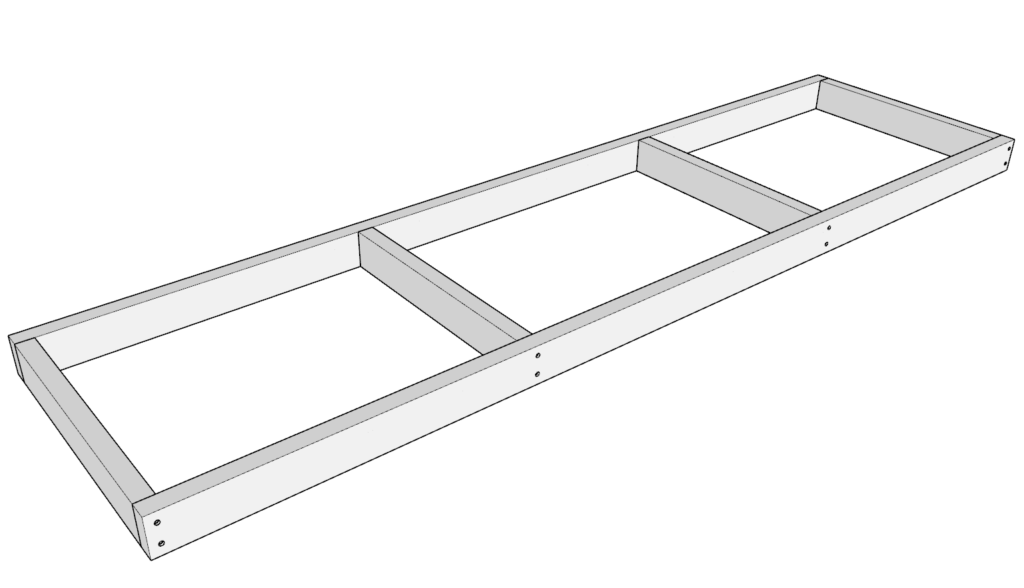
Step 2 (DIY patio bench armrest assembly)
Next, take two 27-1/2 inch 2×4 lumber pieces and two 22-1/2 inch 2×4 lumber pieces and arrange them as shown below. Add glue, predrill holes, and add 2.5 inch screws.
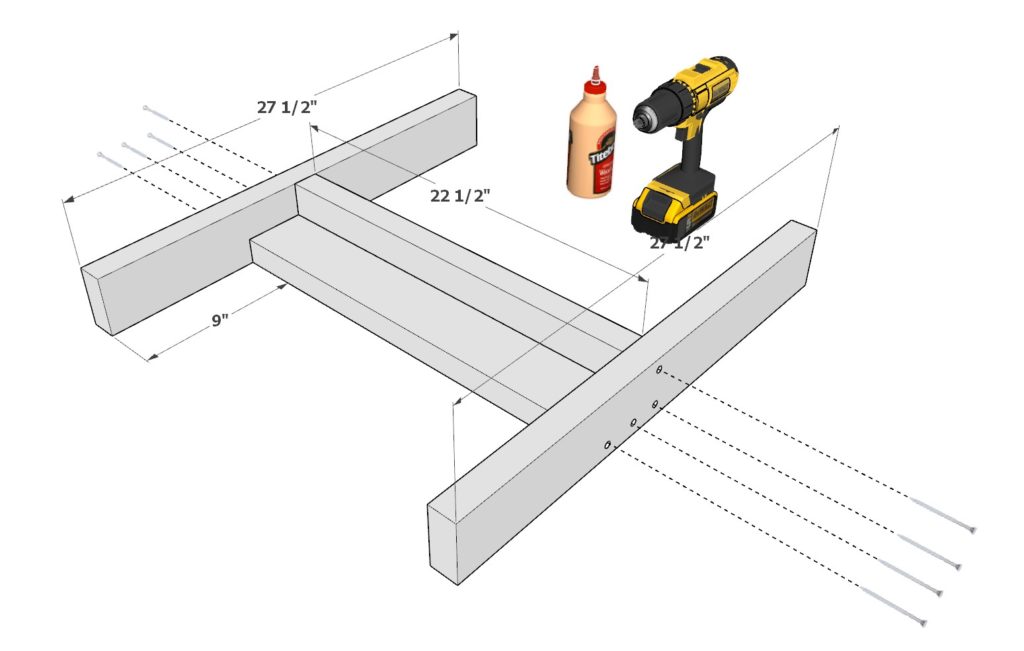
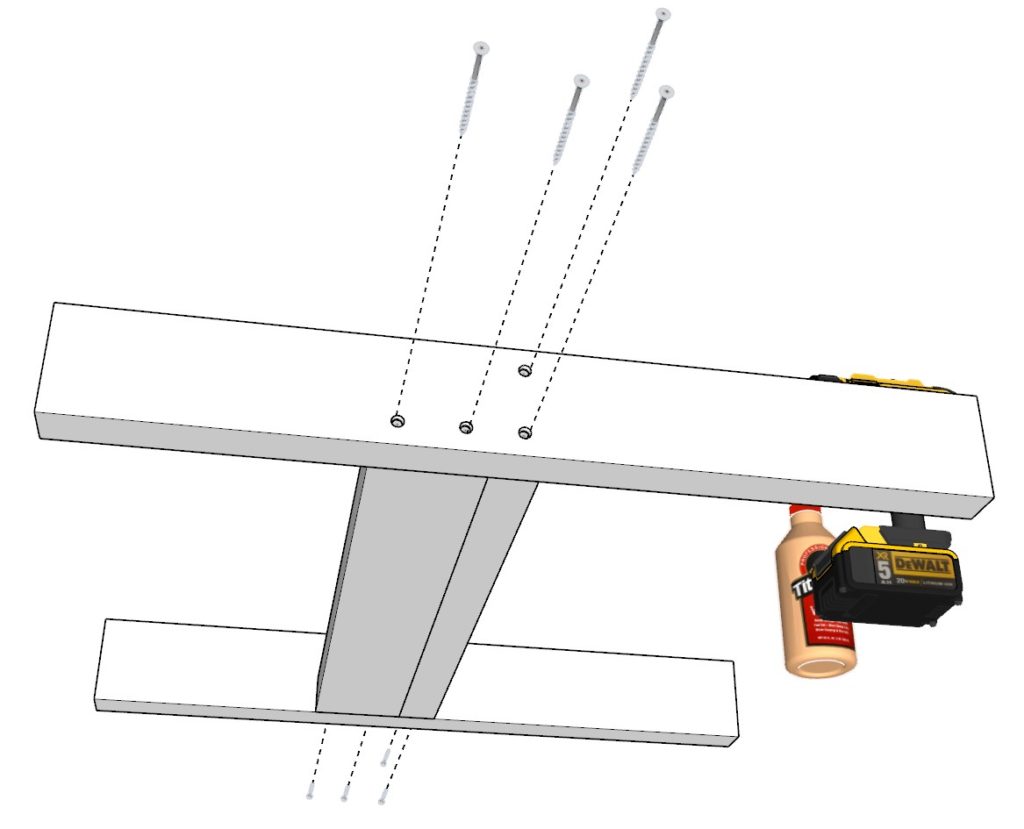
Step 3 (DIY patio bench armrest assembly)
Next, add a 22-1/2 inch 2×4 lumber pieces to the arm rest. It needs to be indented by 1.5 inches. I use a spacer from 2×4 lumber scrap wood for this step since the 2×4 is 1.5 inches thick.
As before, add glue, predrill, and add 2.5 inch screws.
Next, make a second arm rest identical to the one you just made for a total of two arm rests.
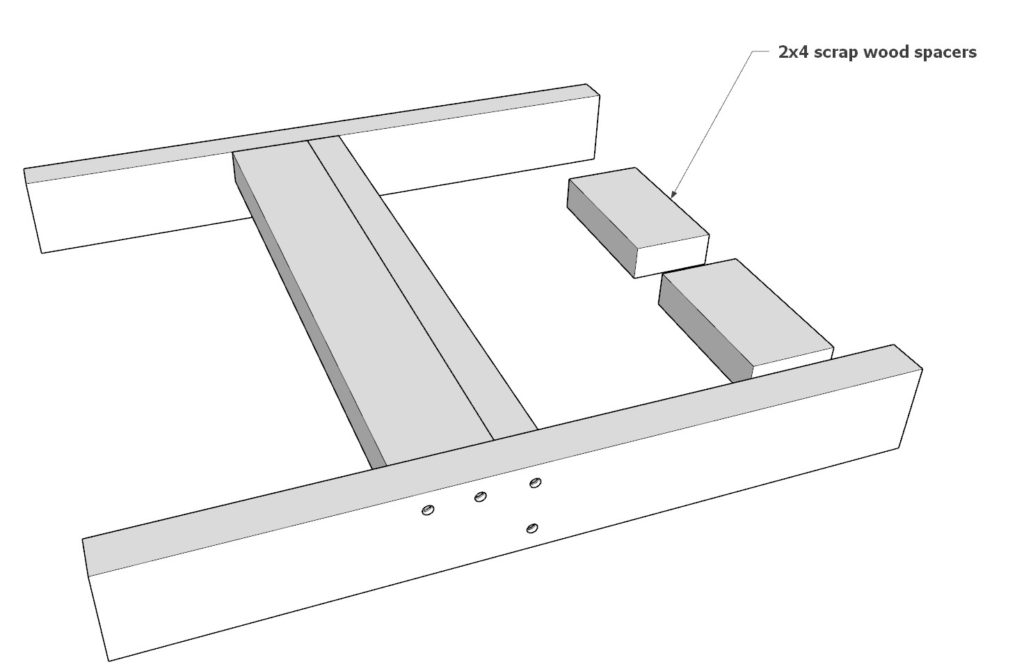
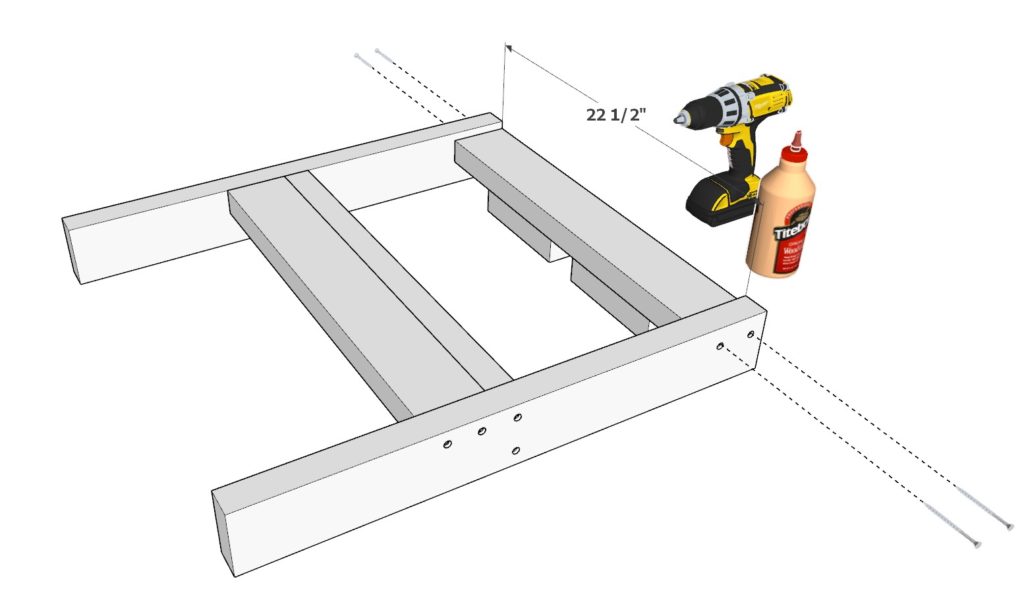
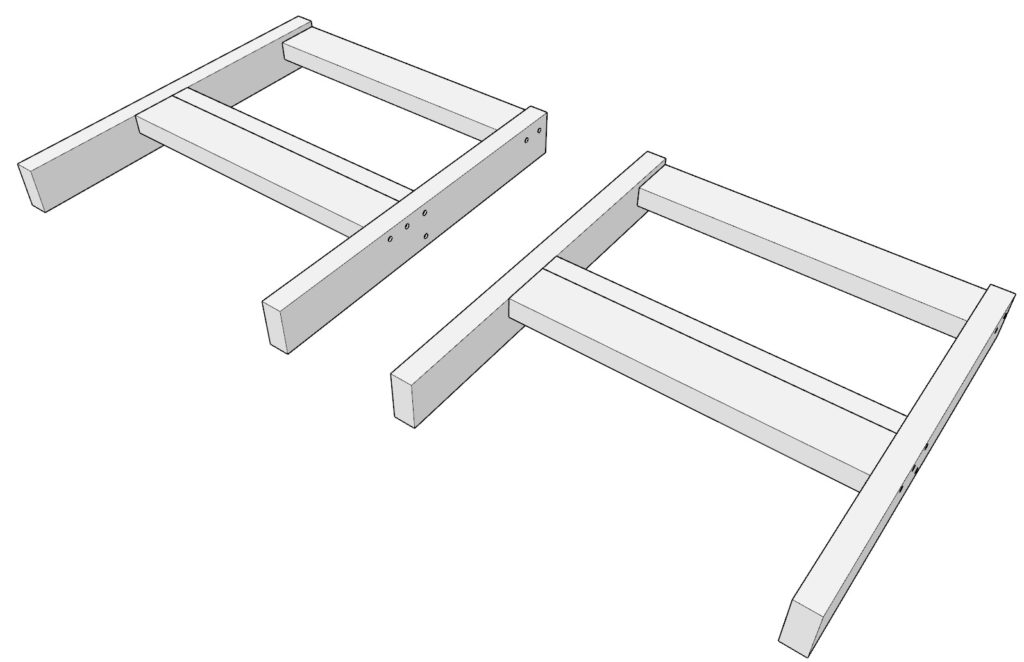
Step 4 (DIY patio bench armrest assembly)
Next, add 27 inch long 2×4 lumber pieces to both of the arm rests.
BE CAREFUL! Make sure that the 27 inch long 2×4 pieces are places in a mirrored fashion to each other. This is indicated by the red arrows in the diagram.
Once you ensure the proper placement of the 27 inch 2×4 lumber pieces then as before, add glue, predrill, and add screws.
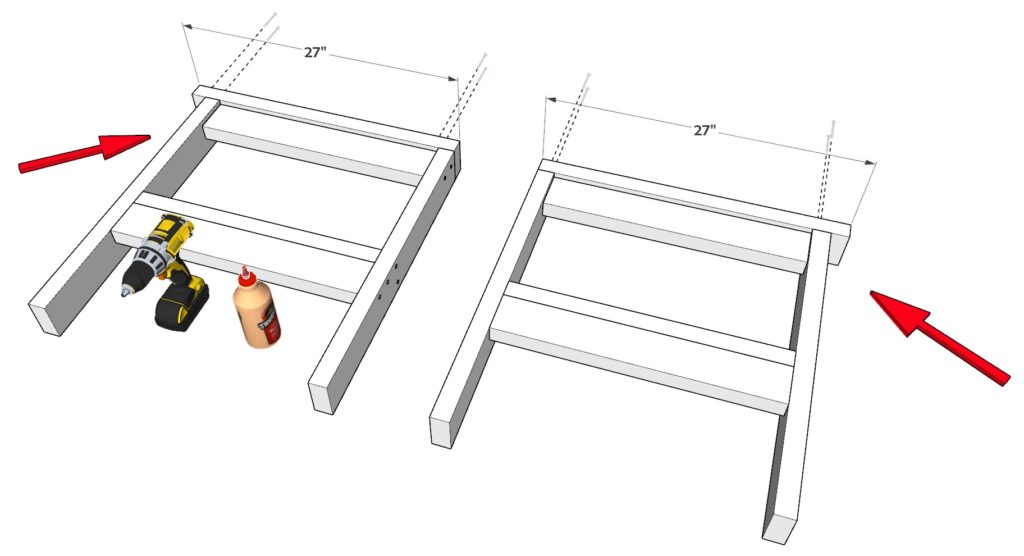


Step 5 (Attaching armrests to the frame of bench)
Next, set the frame up right on top of one of the armrests.
In this step make sure that glue is applied to the areas that will make contact. Get help to balance the frame. Secure the frame with clamps for stability and a more solid joint.
As before, predrill and add screws.
Add both vertical and diagonal screws as shown below for a secure joint.
Repeat this for the other arm rest as well.
Get help to hold up the frame for safety reasons.

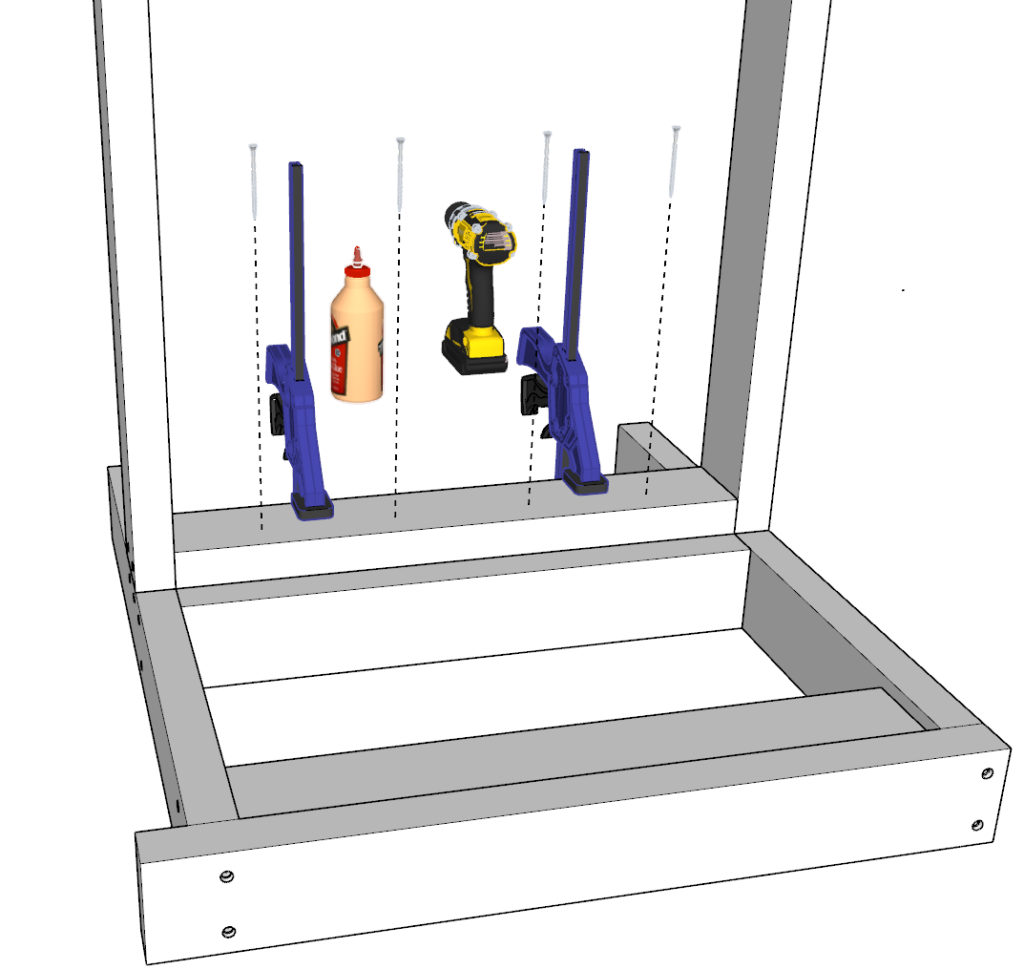



Step 6 (Attaching back rest)
Next, add a 96-in piece across the back. This needs to be glues on the ends and have screws put in diagonally.
Two options exists for installing the 96 inch lumber piece. you can either use a pipe clamp or ratchet straps. (both options shown below).
Pipe clamp: The pipe clamp is the easiest way to keep everything in place and tight as you add the back rest.
Ratchet strap: Using a strap, or several linked together, is another way to add the back rest piece. This is usually less expensive and most households have straps on hand. Link several together is needed to bring the two armrests together and clamp into place the 96 inch 2×4 lumber piece as shown below.


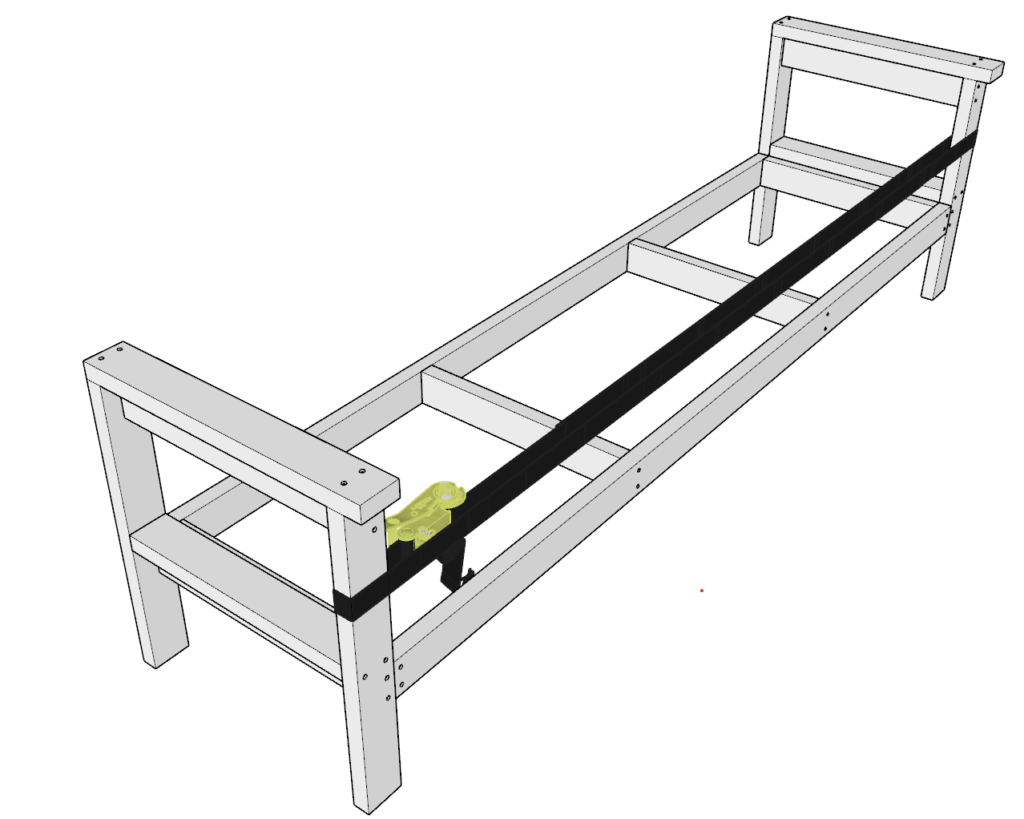
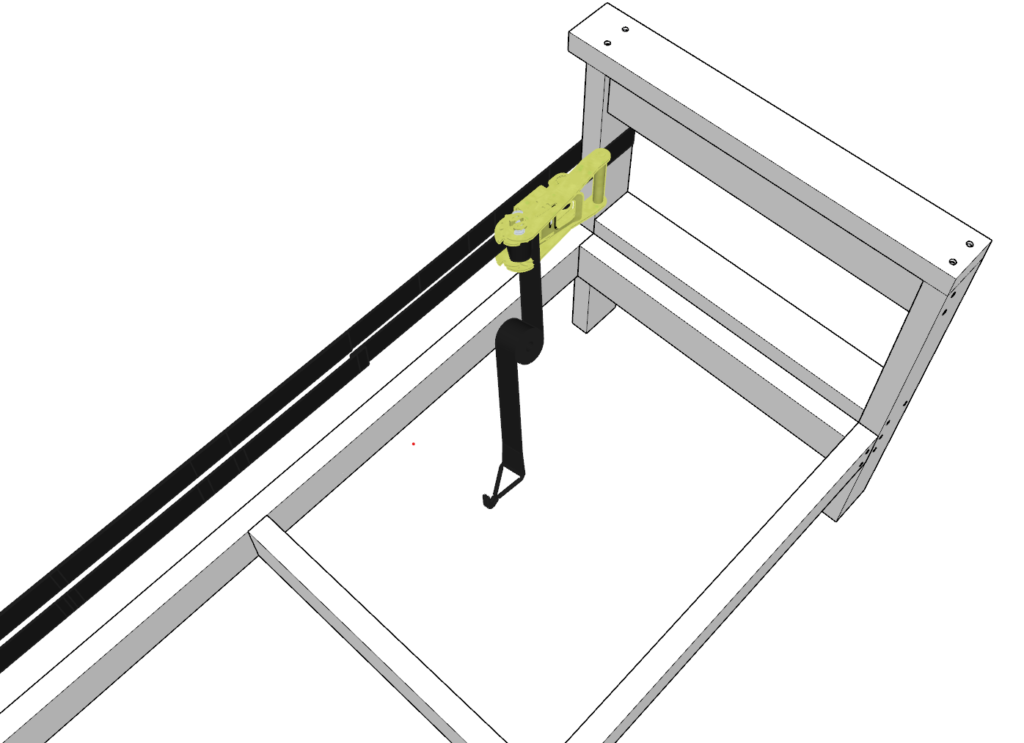
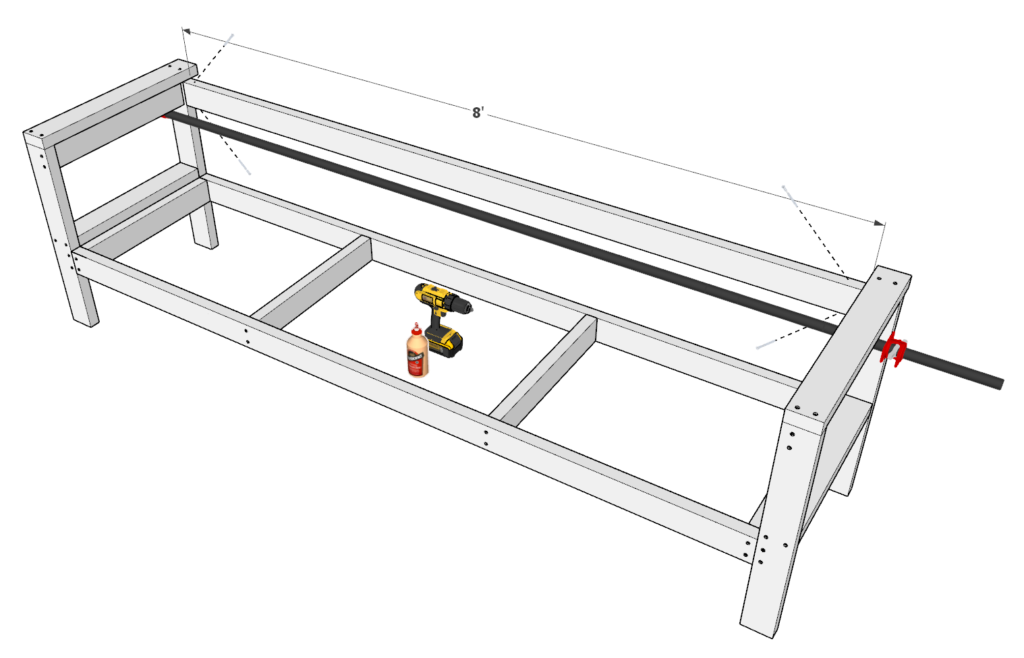

Step 7 (Attaching back rest)
Next, add a 96-in piece on top of the back, glue it (apply across the entire length of the 96-in piece added in the previous step). Add screws and secure it into place.
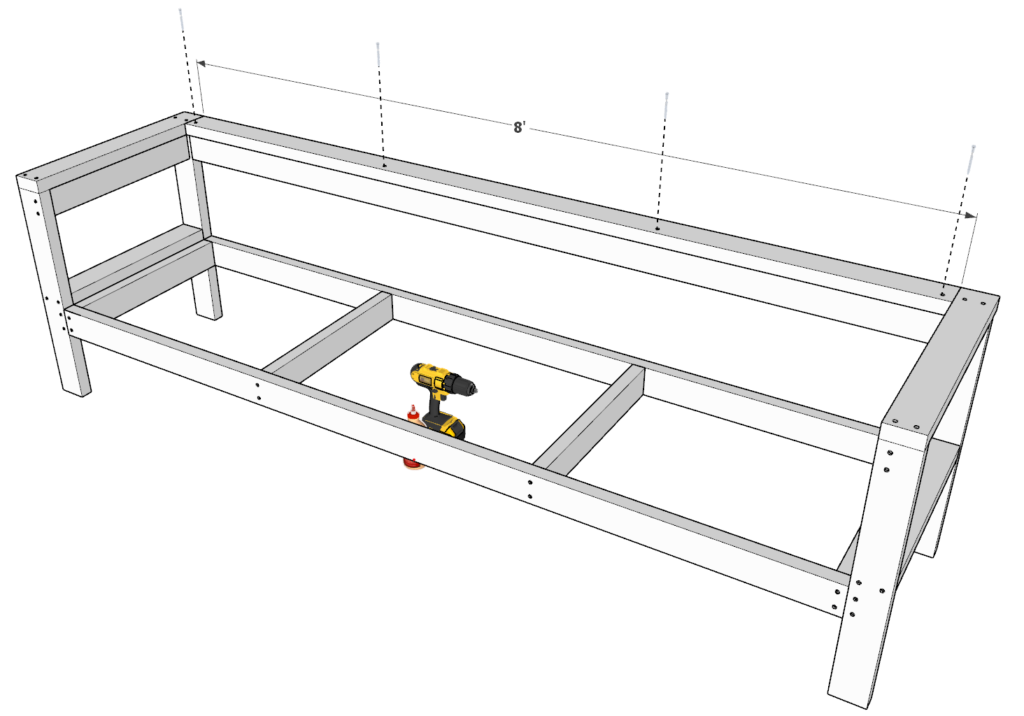
Step 8 (Adding decking pieces)
Next, add the 96-inch decking pieces. Space them apart evenly. The space is about 7/8 inches.
I like to attach the two opposite end pieces first so that I have more control on setting up the middle pieces.
Predrill all the holes and secure with screws.
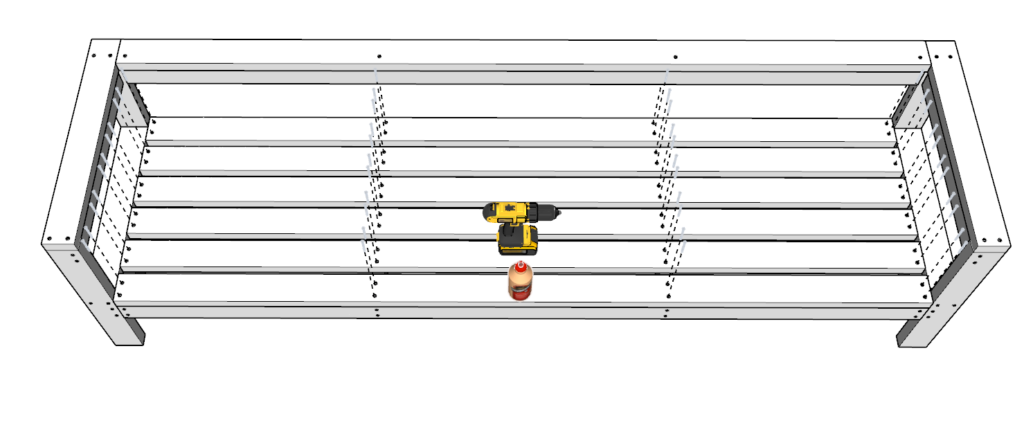
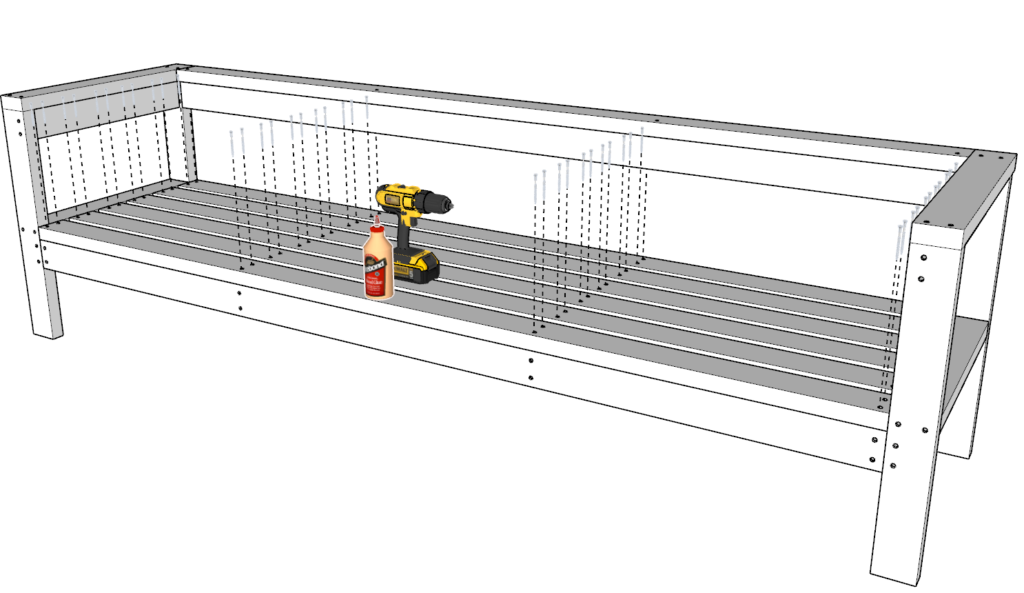
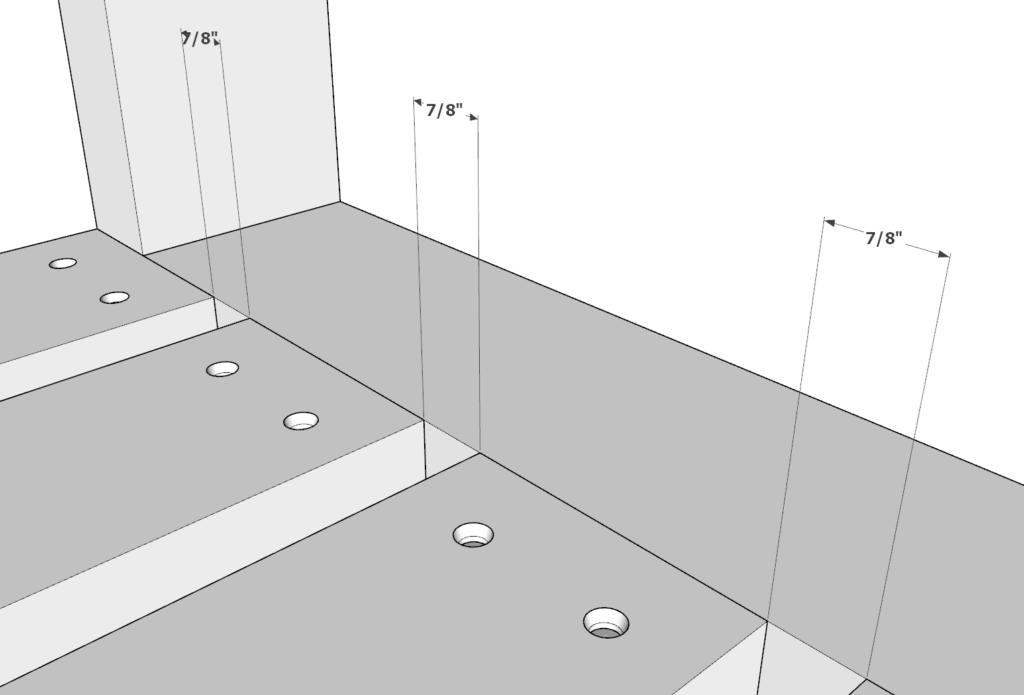
Step 9 (finishing touches)
Next, sand down the whole bench. This can be time consuming. I use an orbital sander to speed up the process
I use a rough 80 grit paper first and then finish it with a 220 grit paper.
Filling in the holes is optional.
At this point it is ready to be stained or painted!
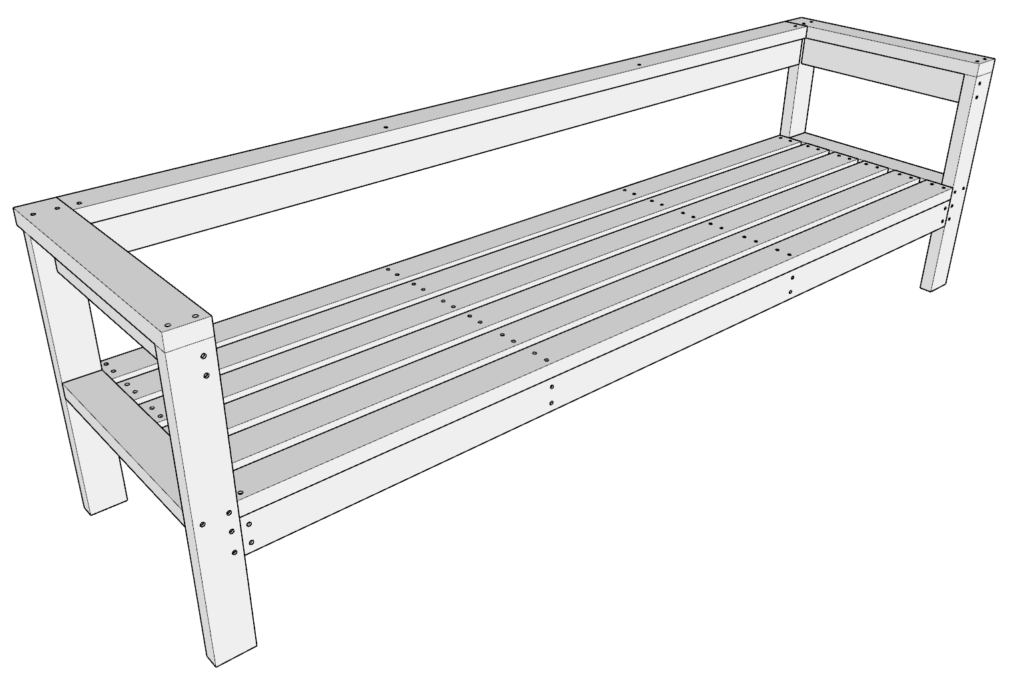
Step-by-step instruction on building the chaise component of the DIY outdoor sectional
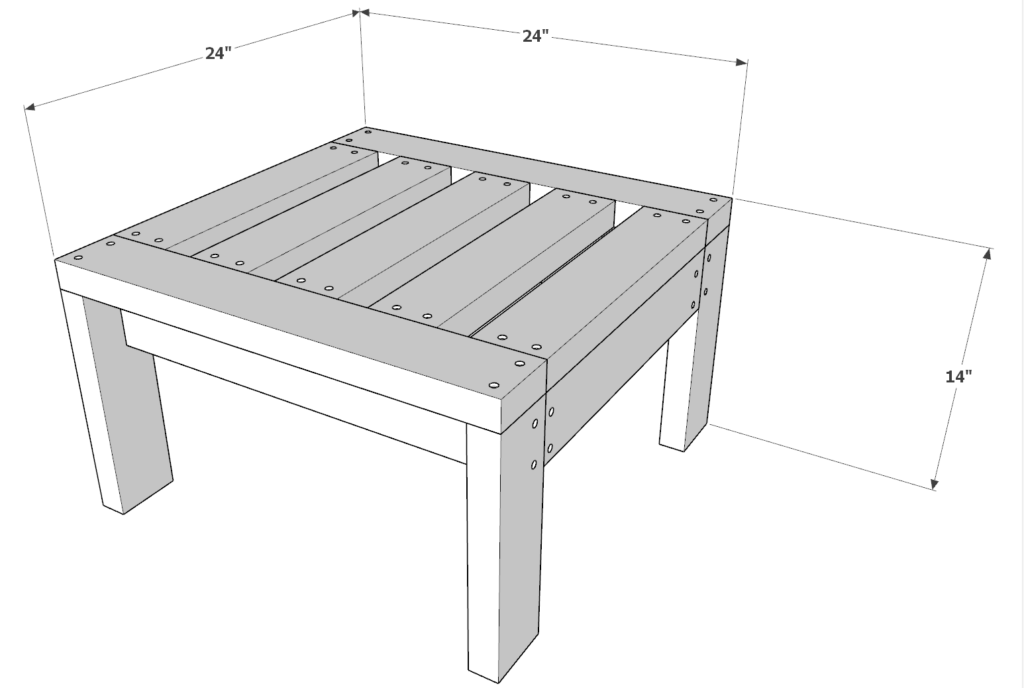
Recommend tools for the chaise component
- Saw (miter saw recommended for precision cuts)
- Drill
- Impact driver with bit for screws
- Sander
- wood countersink drill bit
Cut list and material list for the chaise component
Available with purchase of PDF plans.
Step 1 (chaise component of DIY sectional bench)
Precut all your wood pieces into the following dimensions:
- (7) 2in x 4in x 17in
- (4) 2in x 4in x 21in
- (2) 2in x 4in x 24in
- (4) 2in x 4in x 12.5in
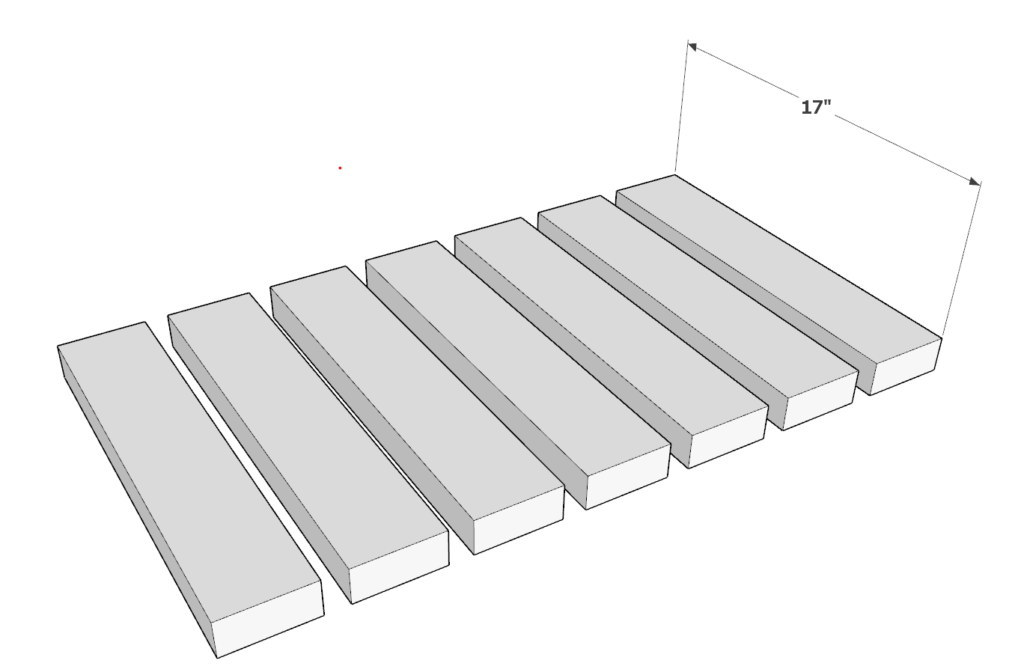
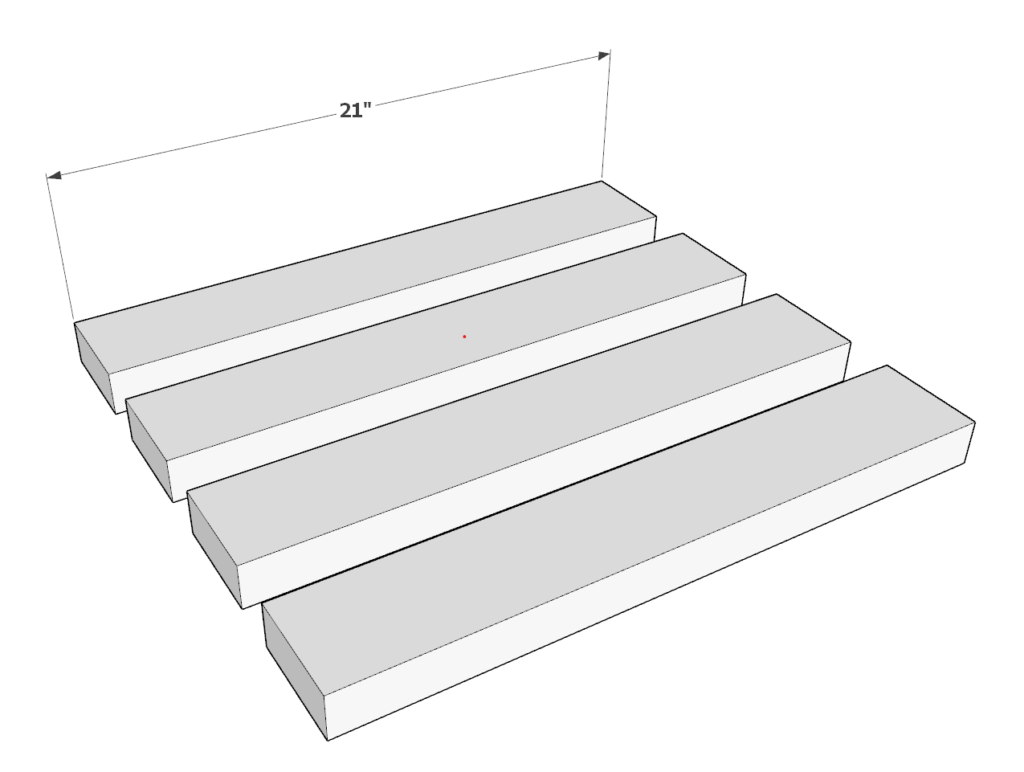
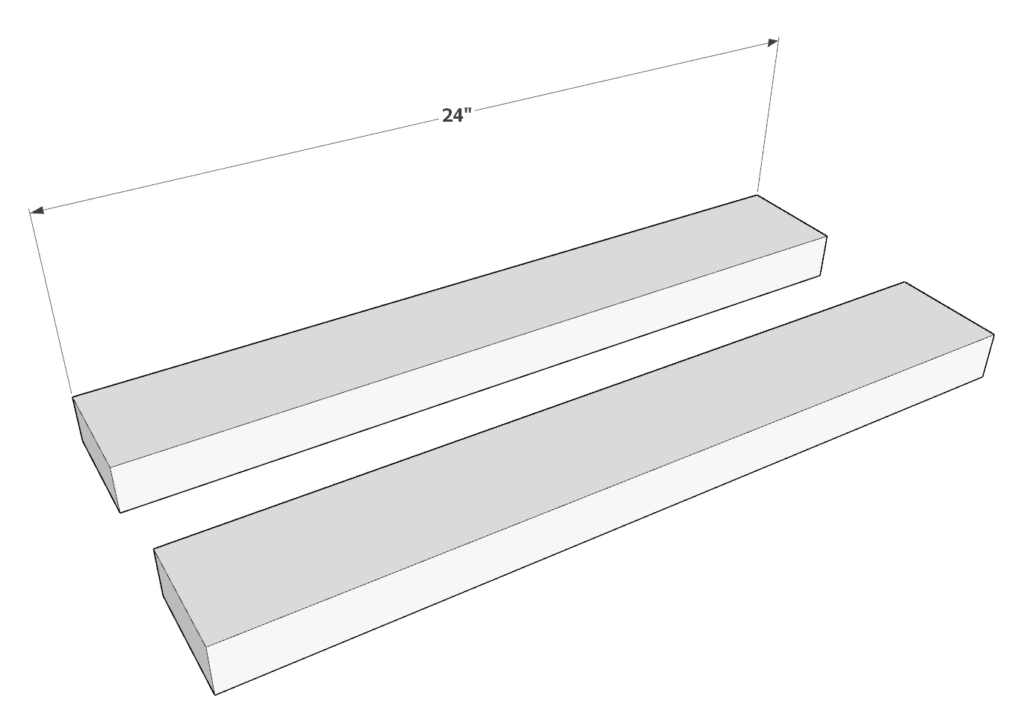
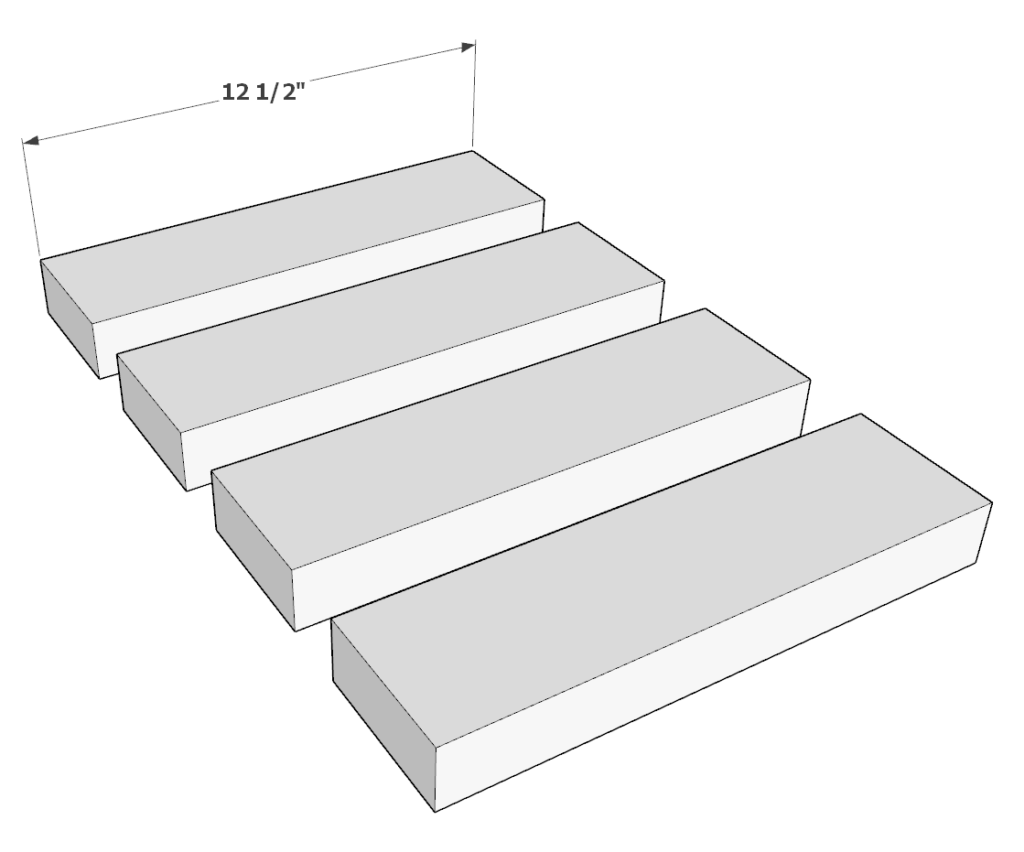
Step 2 (chaise component of DIY sectional bench)
Take two 21 inch 2×4 lumber pieces and two 17 inch 2×4 lumber pieces and arrange them as shown bellow.
Join the pieces by predrilling holes, add glue, and add 2.5 inch long screws.
It is recommended to predrill the wood prior to putting in a screw to prevent the wood from splitting. What works for me is to us a wood countersink drill bit.
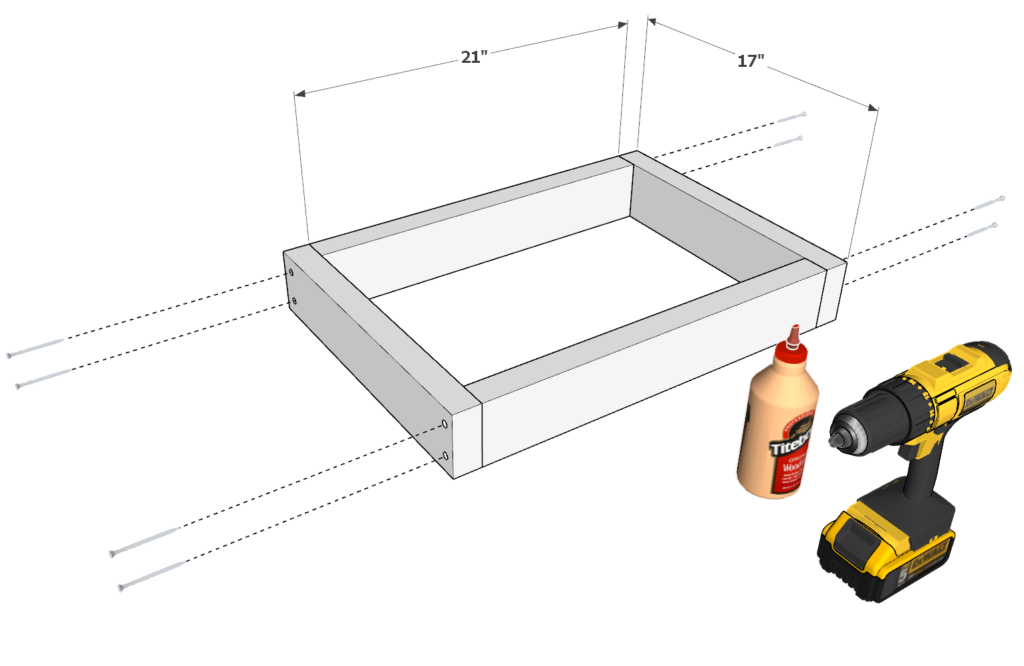
Step 3 (chaise component of DIY sectional bench)
Next, take two 12.5 in 2×4 pieces and one 21 in 2×4 lumber pieces and arrange them as shown in the diagram.
Join together by gluing, predrilling, and adding screws as before.
Repeat this step to have two identical leg frame pieces.
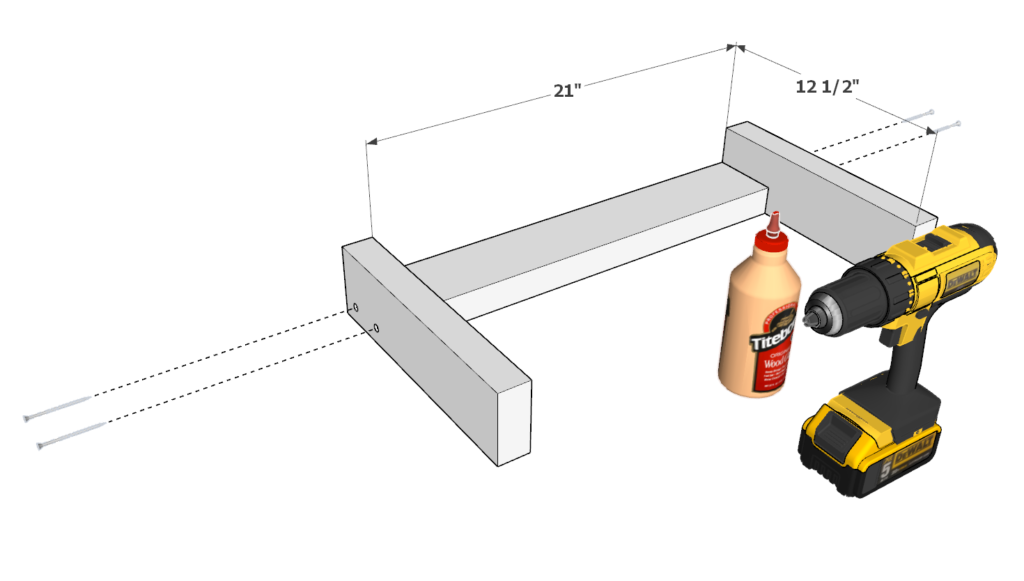

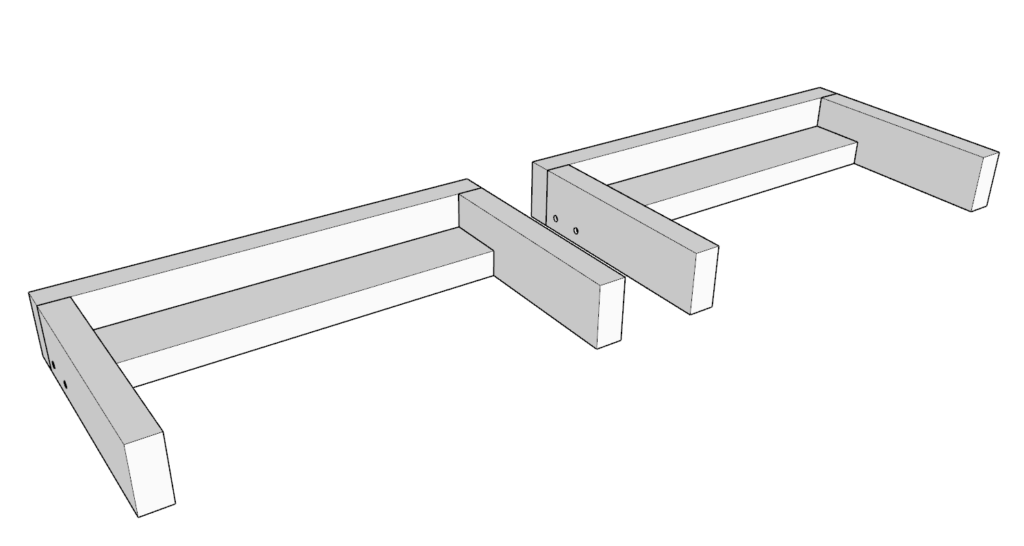
Step 4 (chaise component of DIY sectional bench)
Next, take the frame from the previous step and one of leg pieces and arrange them as shown below.
Use a pencil to draw some boundary lines for where the screws should go. The spaces are the with of the 2×4 decking pieces that will go on top. I place the screws in these specific spaces to make sure they are hidden from view.
As before, add glue, predrill, and add screws.
Add additional screws diagonally for added strength.
Repeat this for the second leg piece as well.
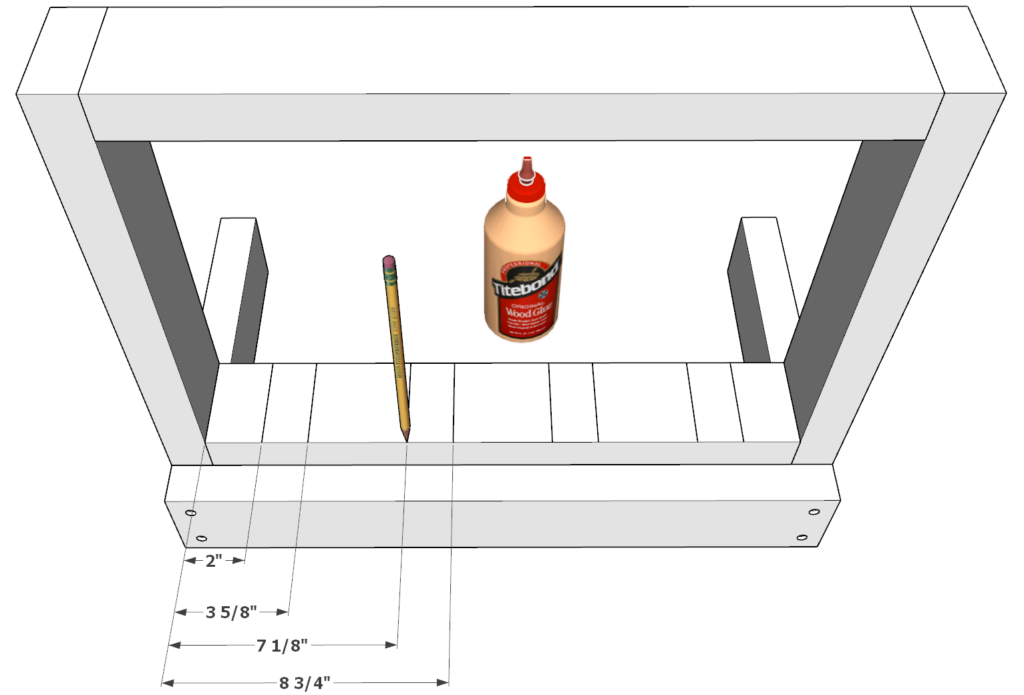
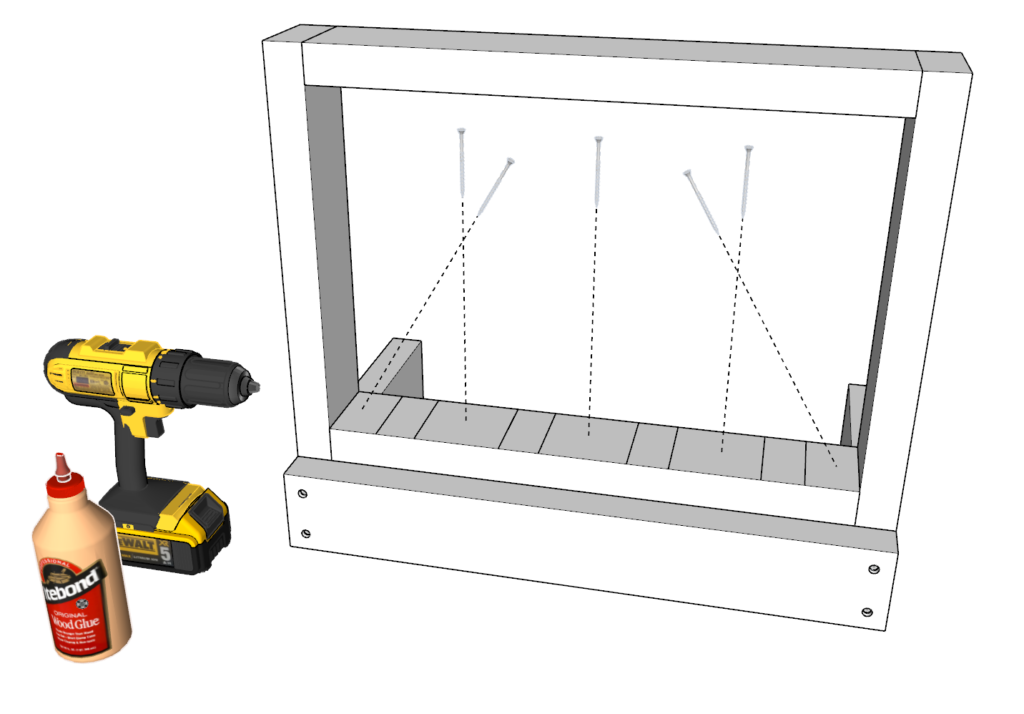
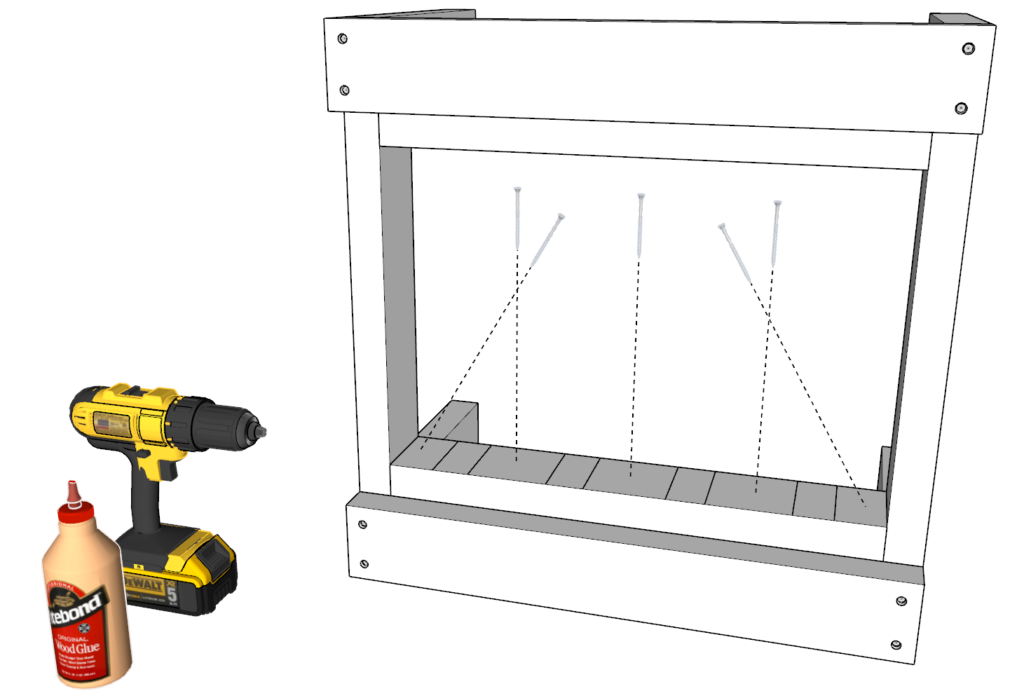
Step 5 (chaise component of DIY sectional bench)
next, add the 17 inch decking pieces to the frame. Space them out evenly. I like to start with the outer tow most decking pieces and work my way in.
As before, add glue, predrill, and add screws.

Step 6 (chaise component of DIY sectional bench)
Next, sand down the whole chaise. I use an orbital sander to speed up the process.
I use a rough 80 grit paper first and then finish it with a 220 grit paper.
Filling in the holes is optional.
At this point it is ready to be stained or painted!

Step-by-step instruction on building the 51.5 inch 2-seater bench component of DIY sectional.

Recommend tools for the 2-seater component
Cut list and material list for the 2-seater component
- Miter saw
- Drill
- Impact driver with bit for screws
- GRIP Clamps
- Sander
- wood countersink drill bit
- will need 25 lb of 2.5-in screws (highly recommend T25 Star Drive screws)
- pencil
- Wood glue
- sand paper
- Pipe clamp grip, tie downs, or straps.
Disclosure: Some of these links are affiliate links.
Available with purchase of PDF plans.
Step 1: Frame assembly
First, place two 44.5-in pieces and three 22.5-in pieces in the arrangement shown bellow.
As before, predrill the holes, apply glue, and screw in the screws.
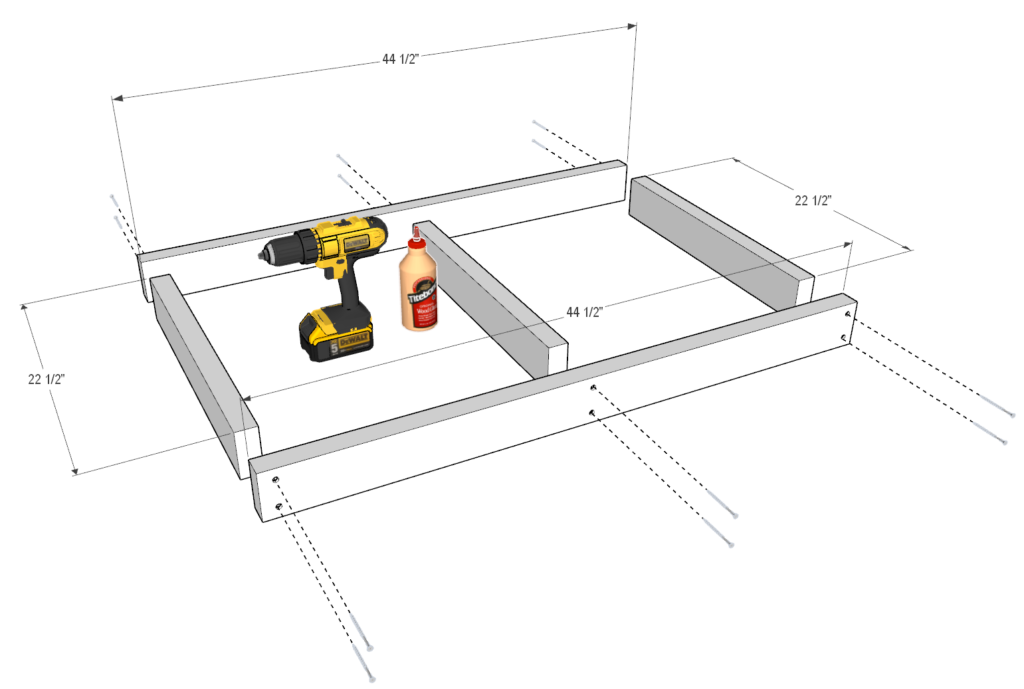
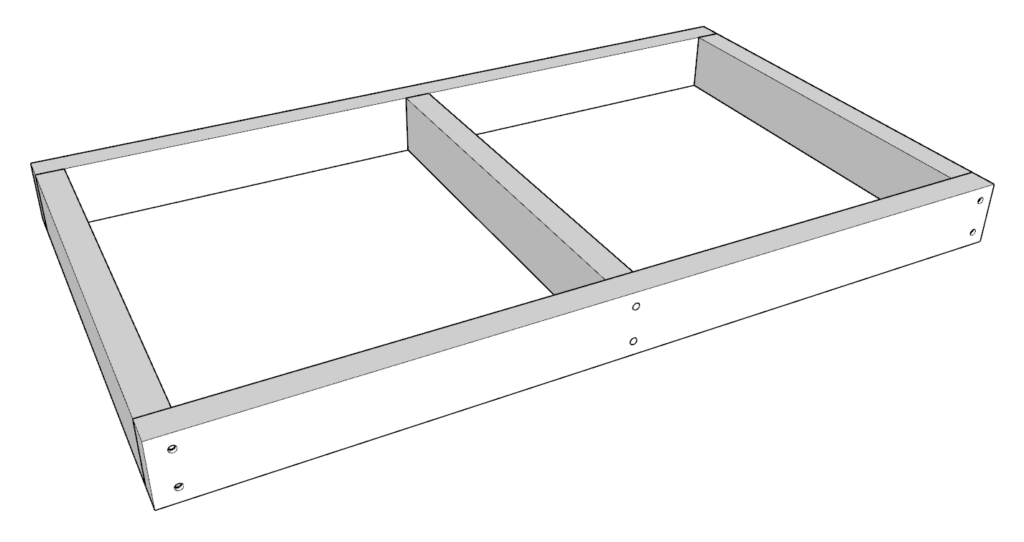
Step 2: Armrest assembly
Next, assemble one of the armrests.
Take two 27-1/2 inch 2×4 lumber pieces and two 22-1/2 inch 2×4 lumber pieces and arrange them as shown below.
Once the pieces are in place, add glue, predrill, and add 2.5 inch screws.
Next, attach a 22-1/2 inch 2×4 lumber piece at the top of the armrest. Use 1.5 inch thick spacers to indent the 22-1/2 inch 2×4 lumber piece appropriately. These spacers can be from cut away 2×4 lumber.
Secure the 22-1/2 inch 2×4 lumber piece by predrilling, gluing, and adding 2.5 inch screws.



Step 3: Arm rest assembly continued
Next, add a 27 inch 2×4 lumber piece to the top of the arm rest as shown below.
Secure by predrilling, adding glue, and adding screws.


Step 4: Second armrest assembly
Next, assemble the second arm rest.
Take one 12-1/2 inch 2×4 lumber piece, one 22-1/2 inch 2×4 lumber piece, one 27-1/2 inch 2×4 lumber piece, and one 24 inch 2×4 lumber piece and arrange them as shown below.
Once they are in place, secure the joints by predrilling, using glue, and adding 2.5 inch screws.
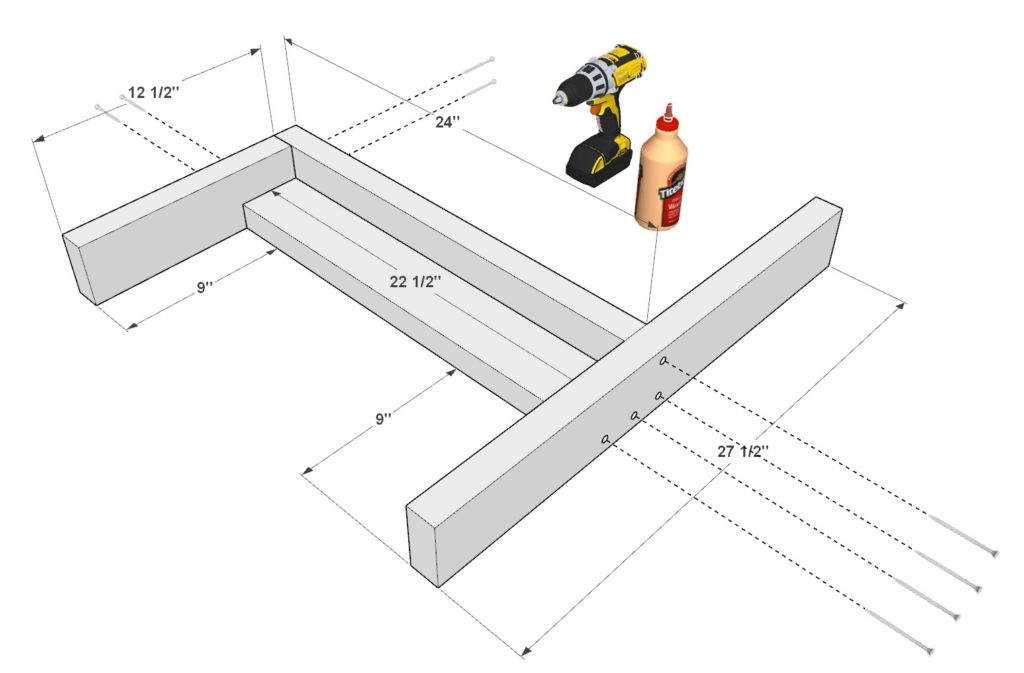
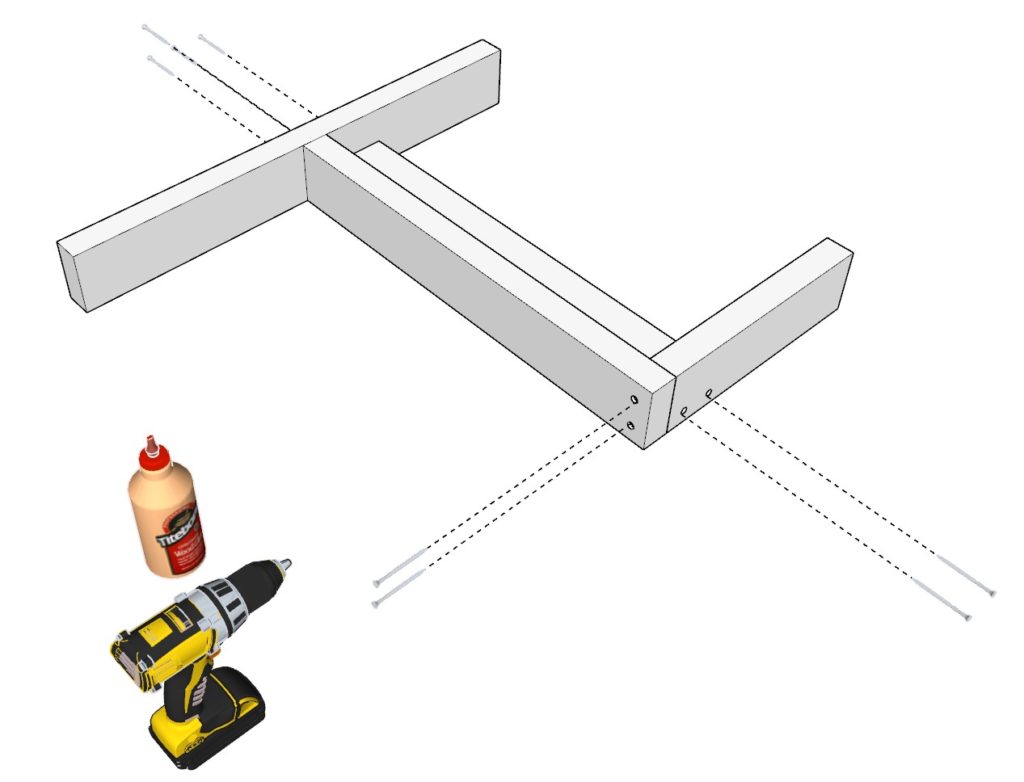
Step 5: Attaching arm rests to frame
Next, attach the frame of the bench to the arm rests.
Take one of the arm rests and align it with the frame as shown below. Apply glue to all areas that will be joined together.
Use clamps to secure the frame in place as you place the vertical and diagonal screws into the wood.
Dont forget to predrill.
Repeat this for both arm rests.


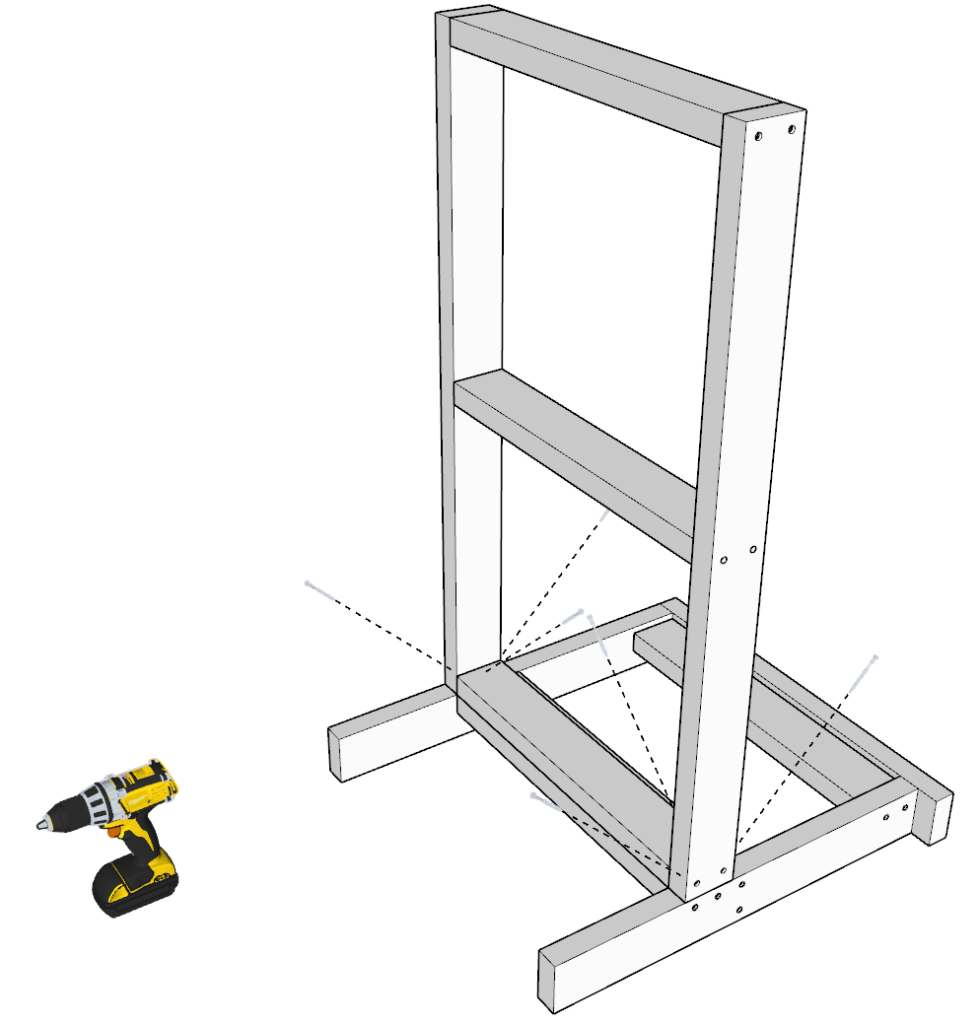

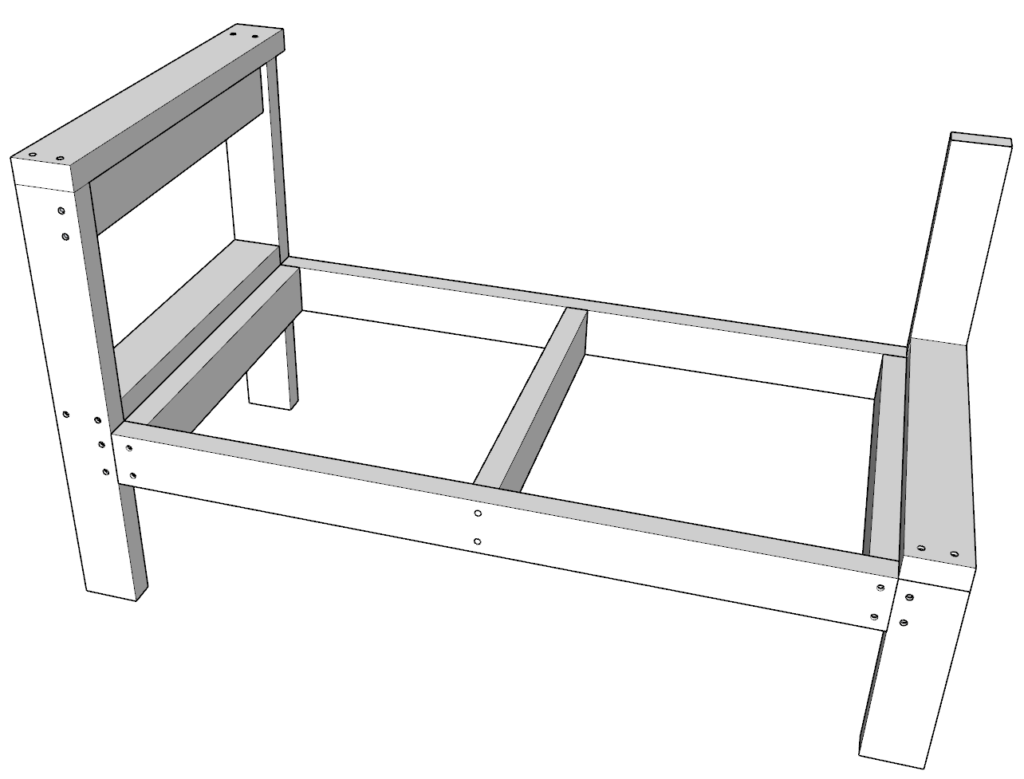
Step 6: Attaching backrest to patio bench
Next, attach the back rest to the patio bench.
Take a 44-1/2 inch 2×4 lumber piece and add it to the back of the bench as shown below. Add glue to all areas that will be joined together.
Use a pipe clamp or a ratchet strap/tie-down to secure the 44-1/2 inch 2×4 lumber piece in place as you add the diagonal screws.
Next add the 48- inch 2×4 lumber piece on top of the back rest. Secure it by predrilling, adding glue and 2.5 inch screws.
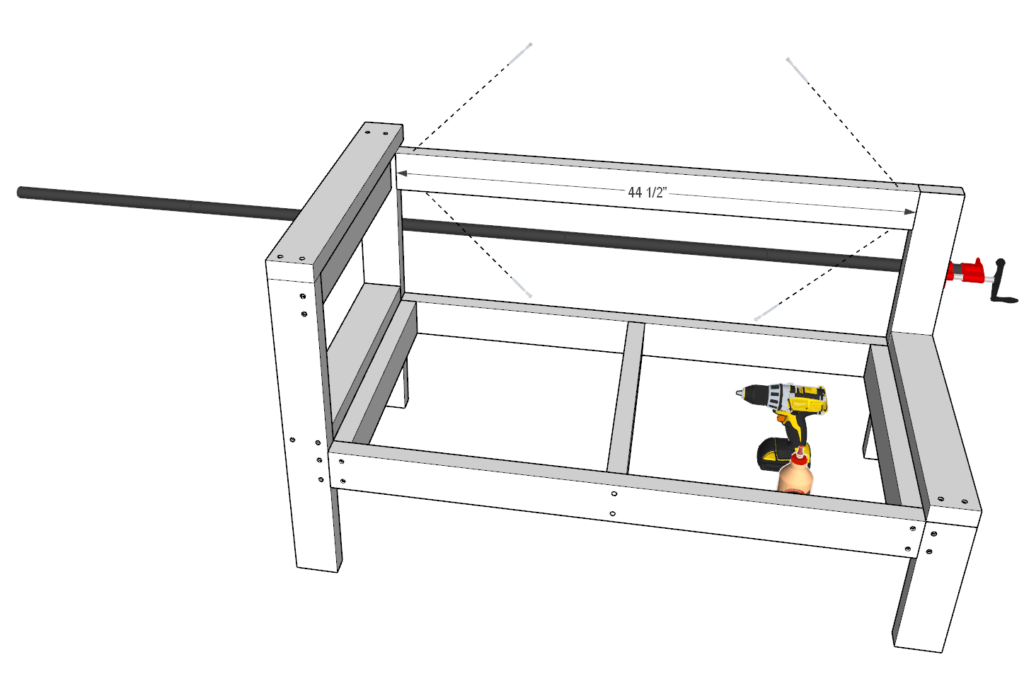
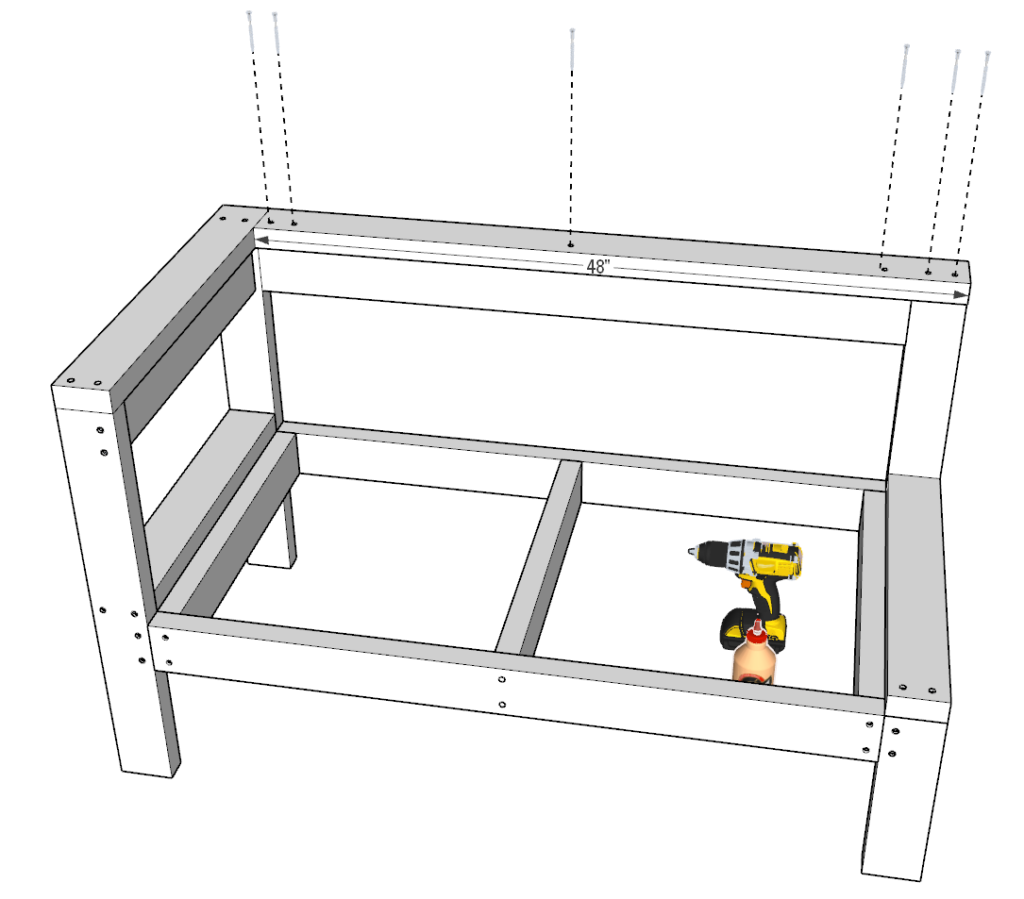
Step 7: adding decking pieces
Next, add six 44-1/2 inch 2×4 lumber pieces to deck the seating platform.
Space out the pieces 7/8 inches apart.
As before, add glue, predrill, and add 2.5 inch screws.
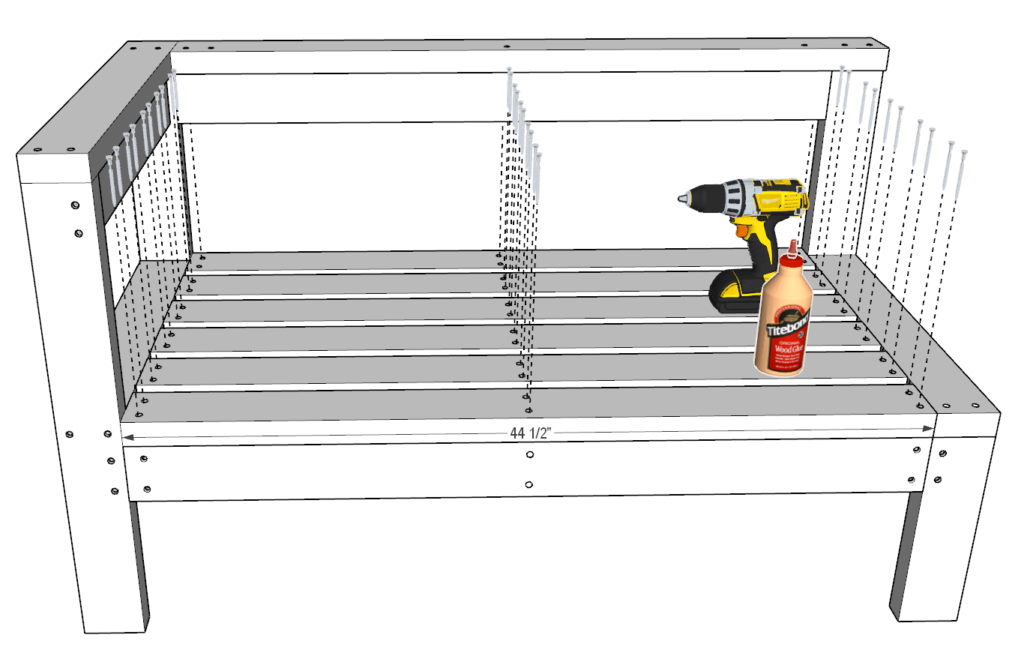
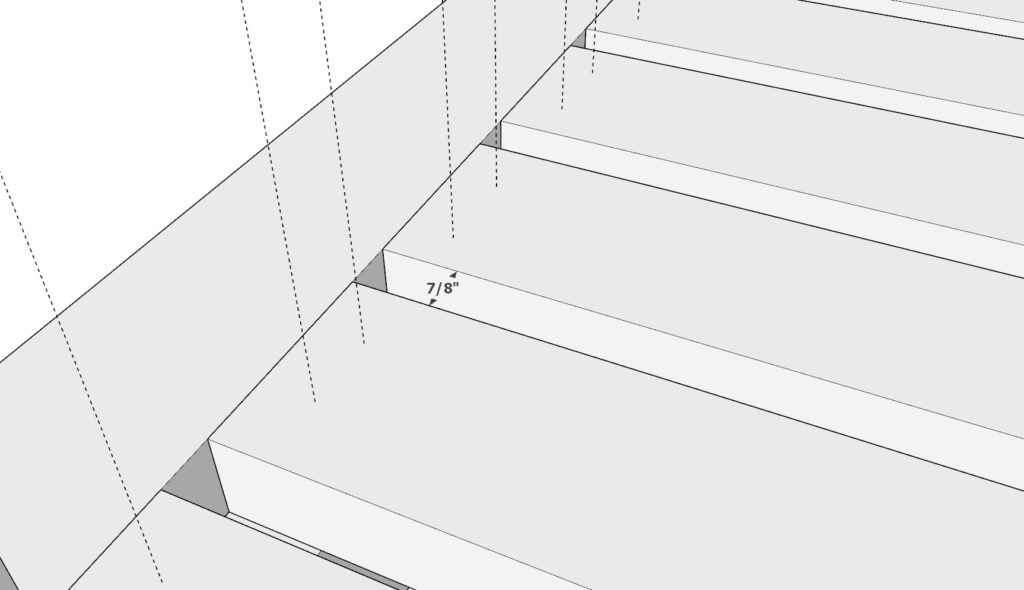
Step 8: finishing touches
At this point all the pieces have to be sanded down. I use a 80 grit paper for my orbital sander to help take away all major imperfections and then I follow up with a fine grit 220+ afterwards to have it be ready to be stained or painted.

Putting it all together
Lastly, arrange the pieces as shown below and your done!
